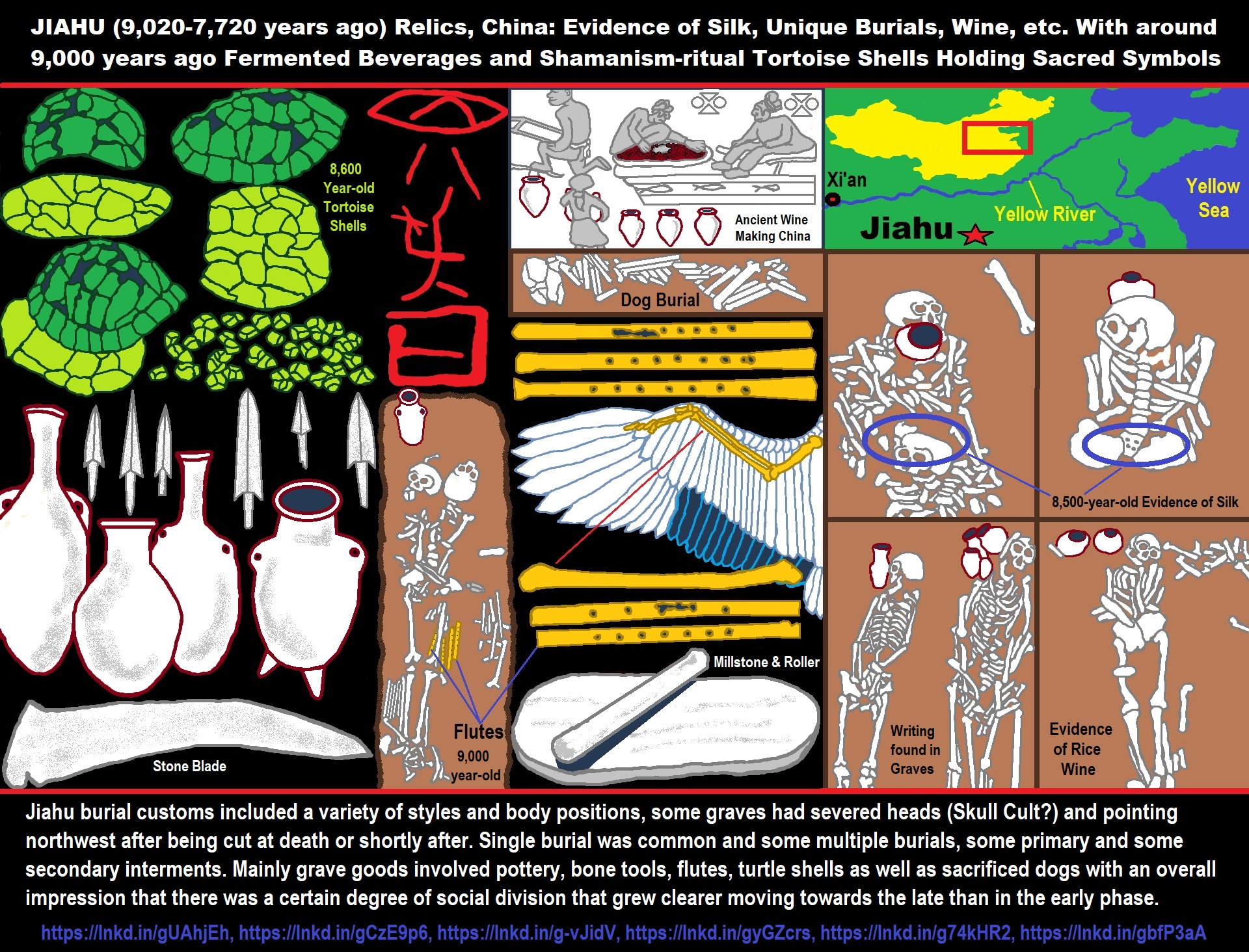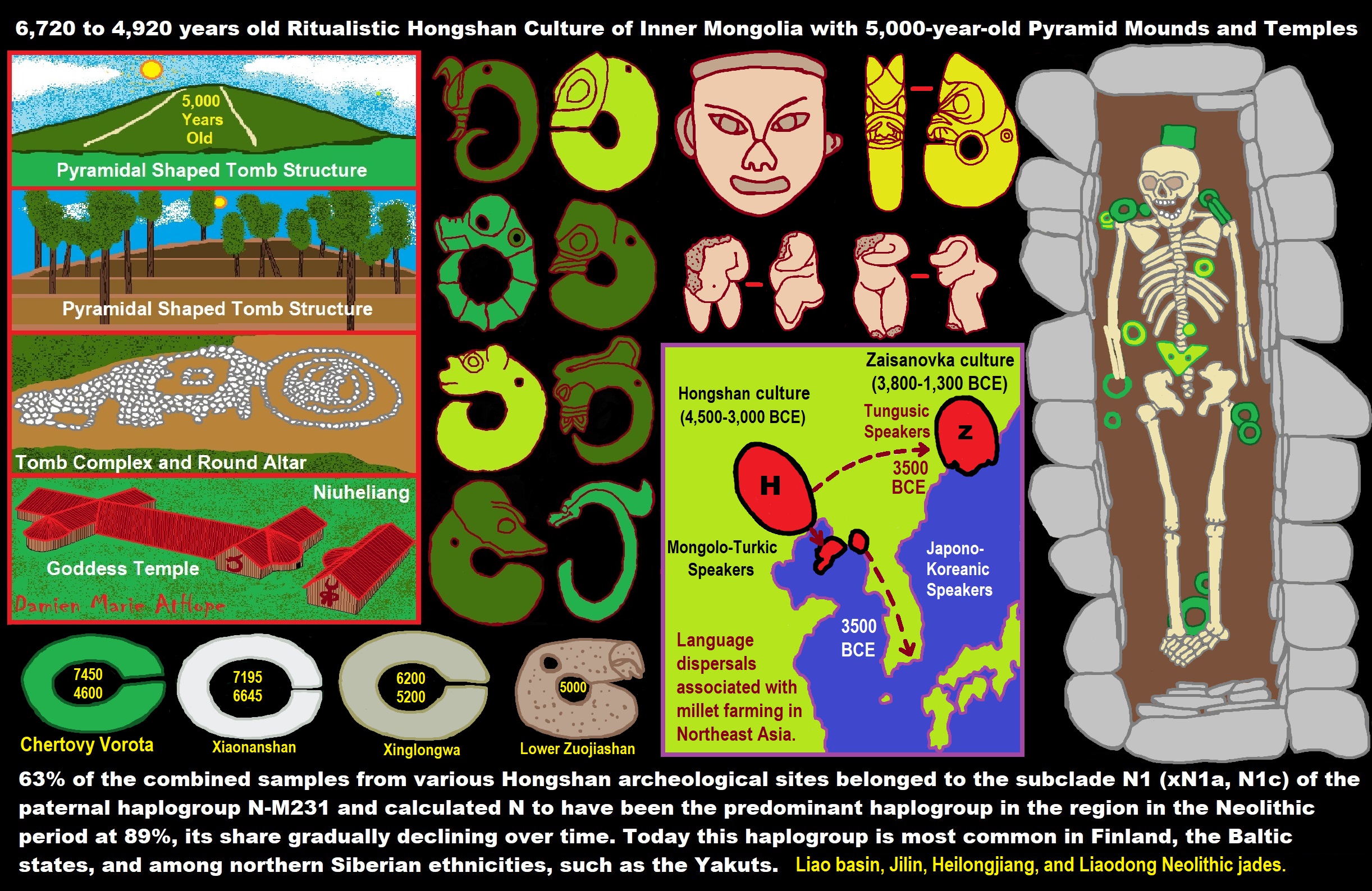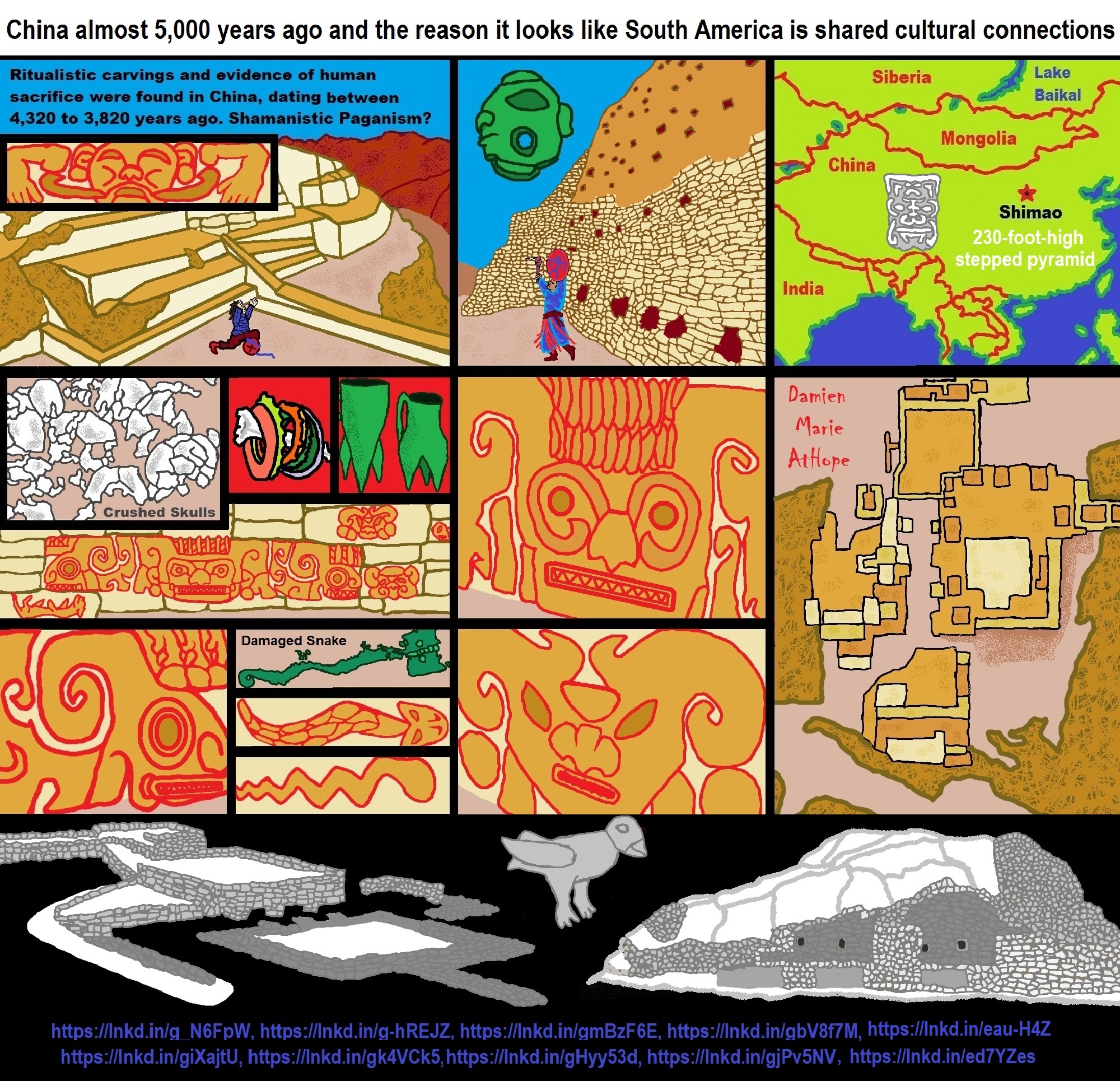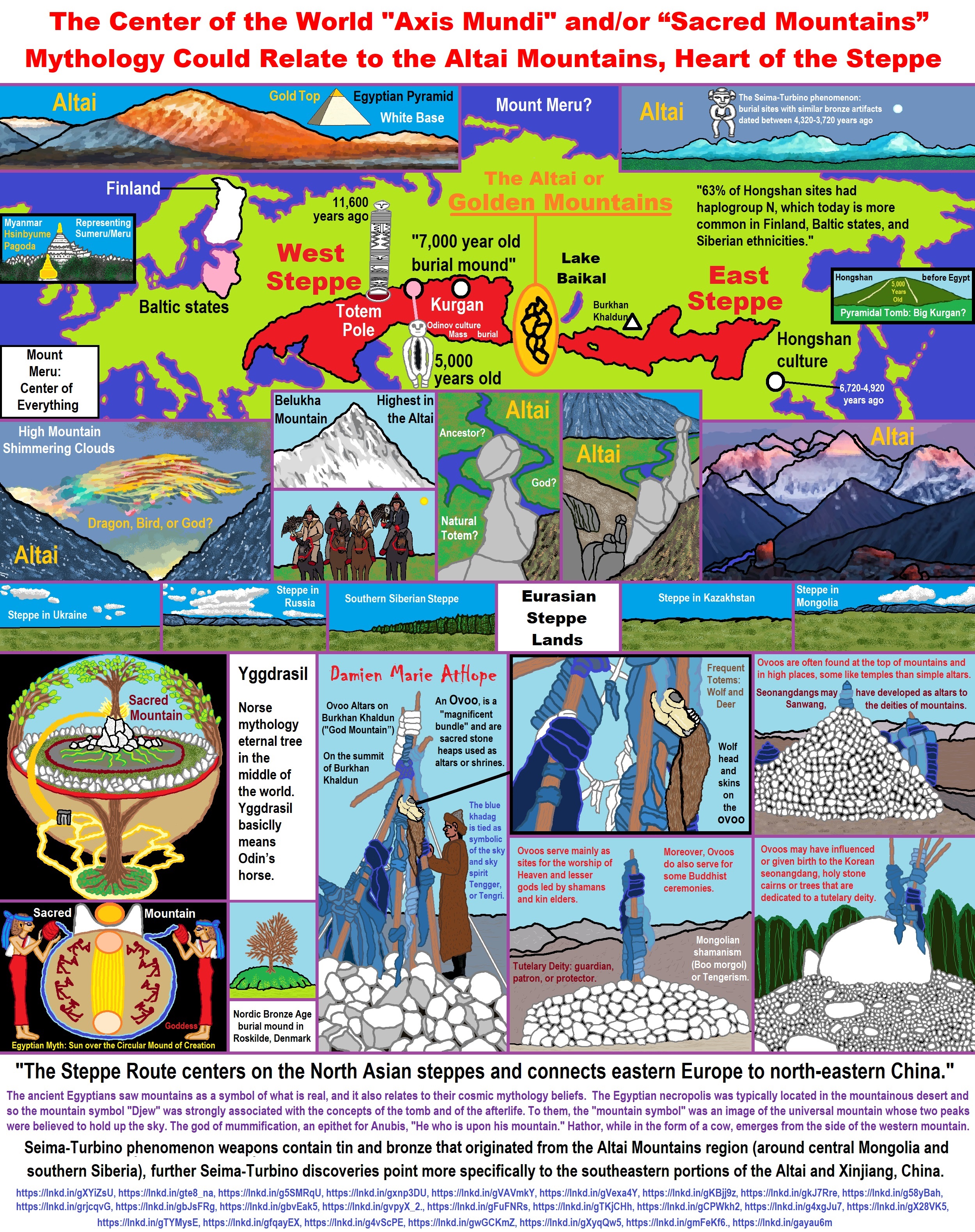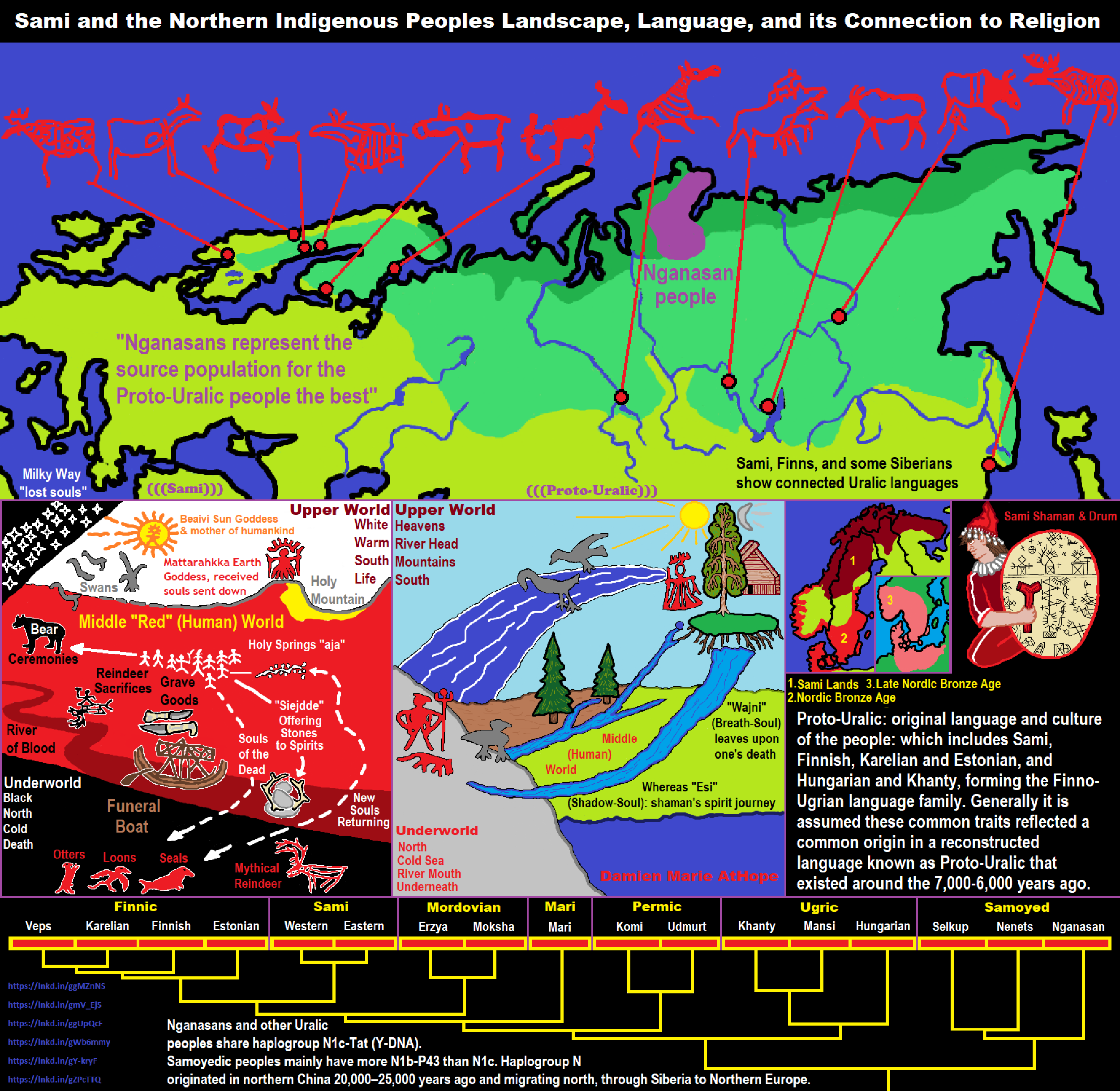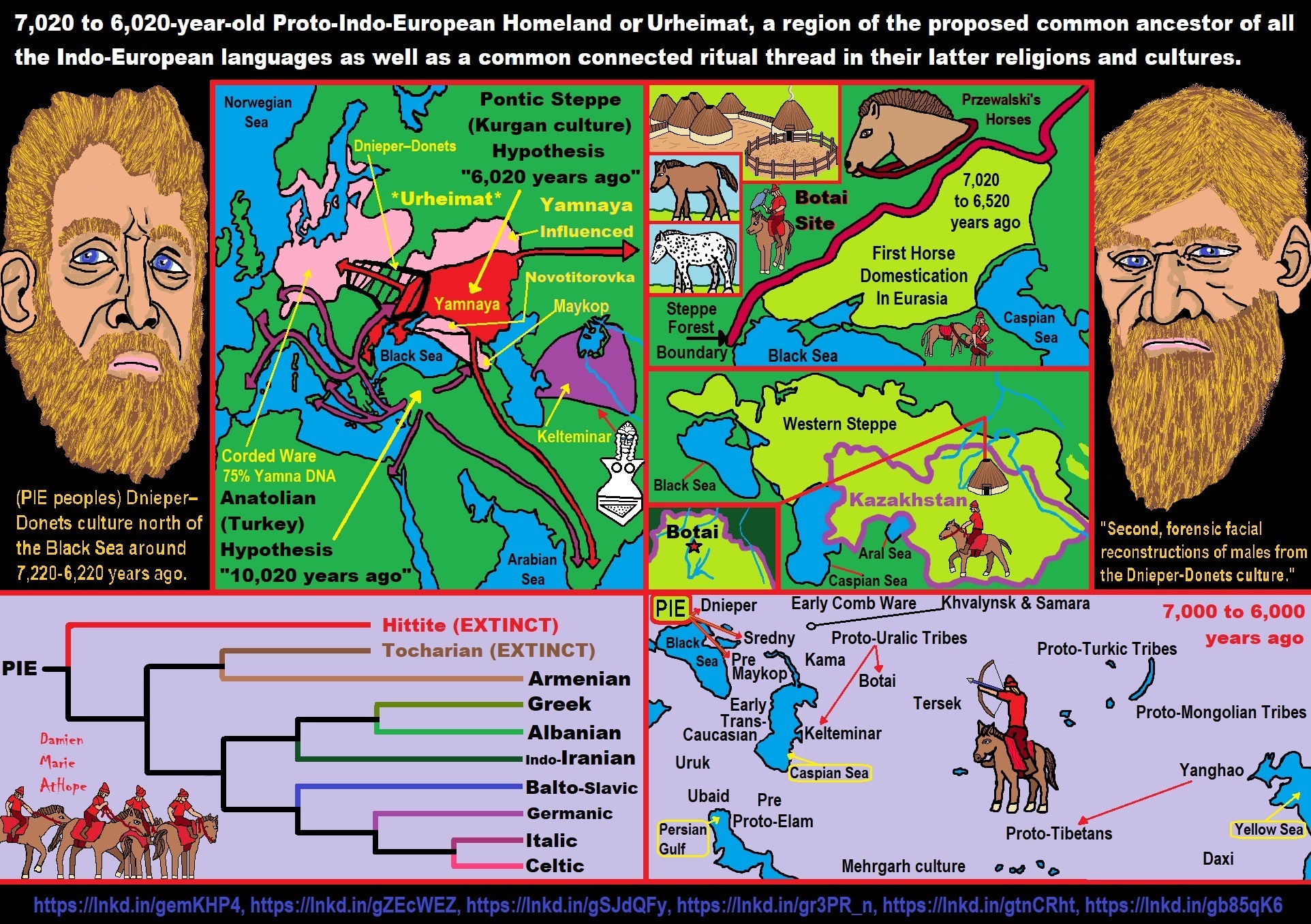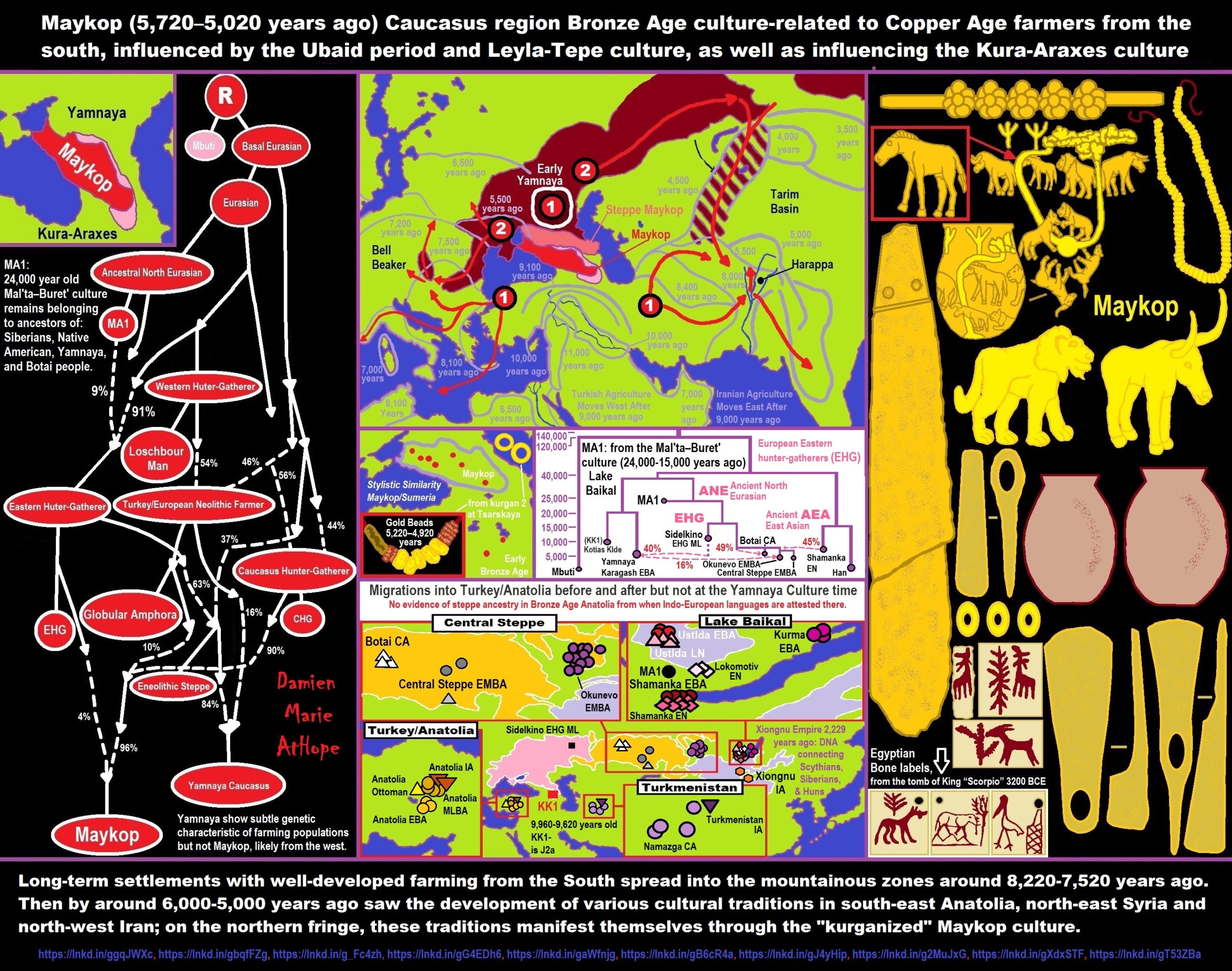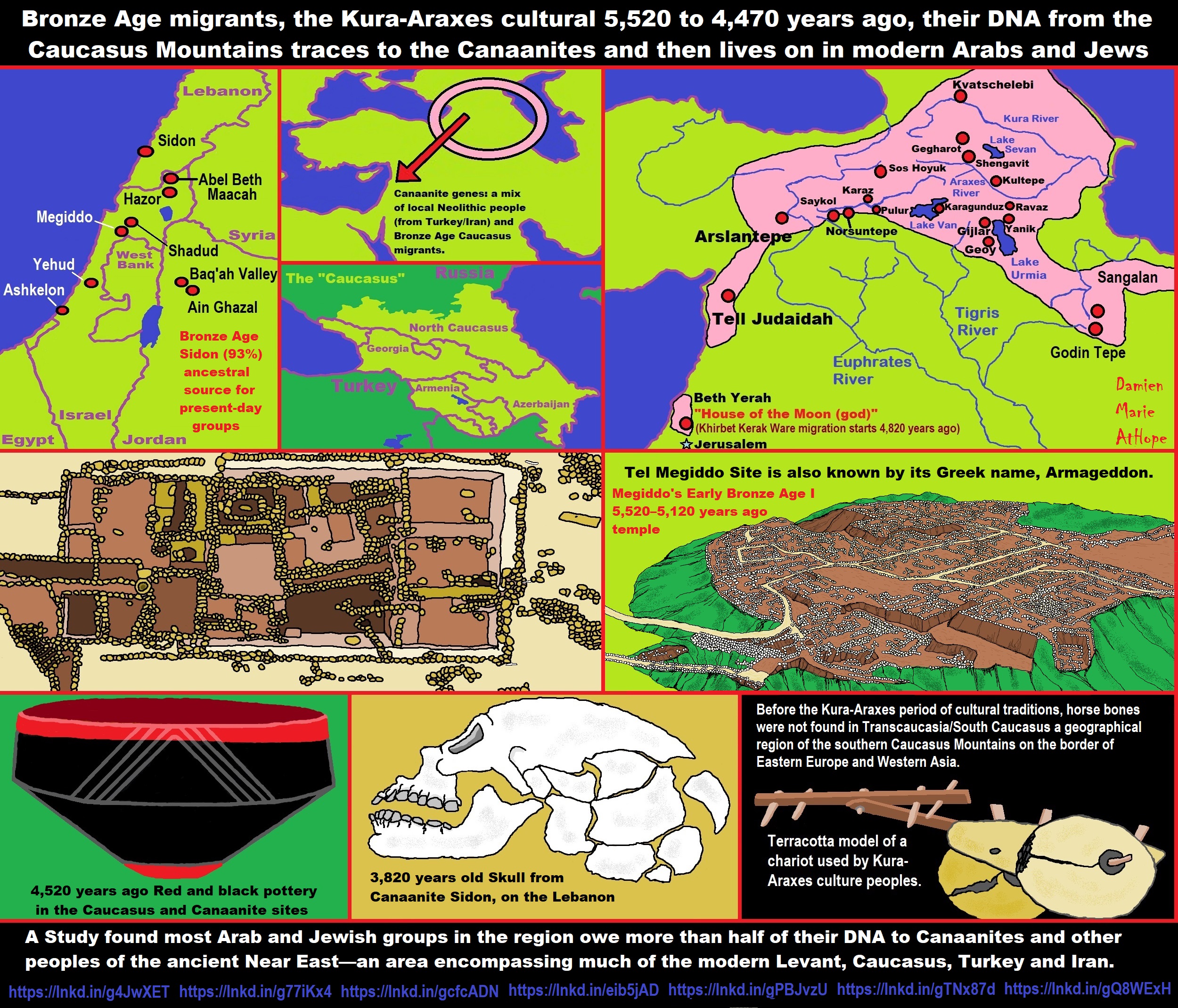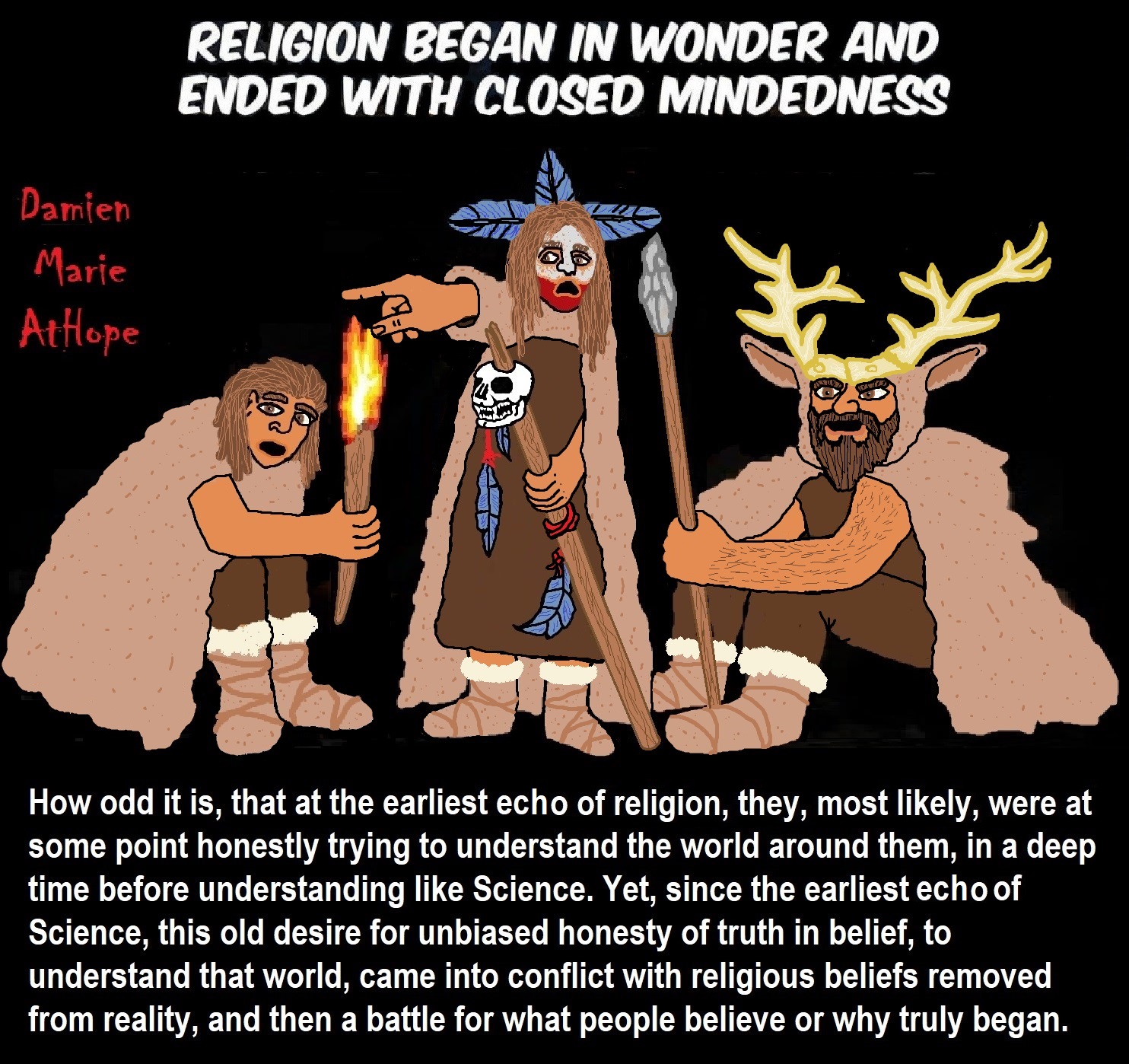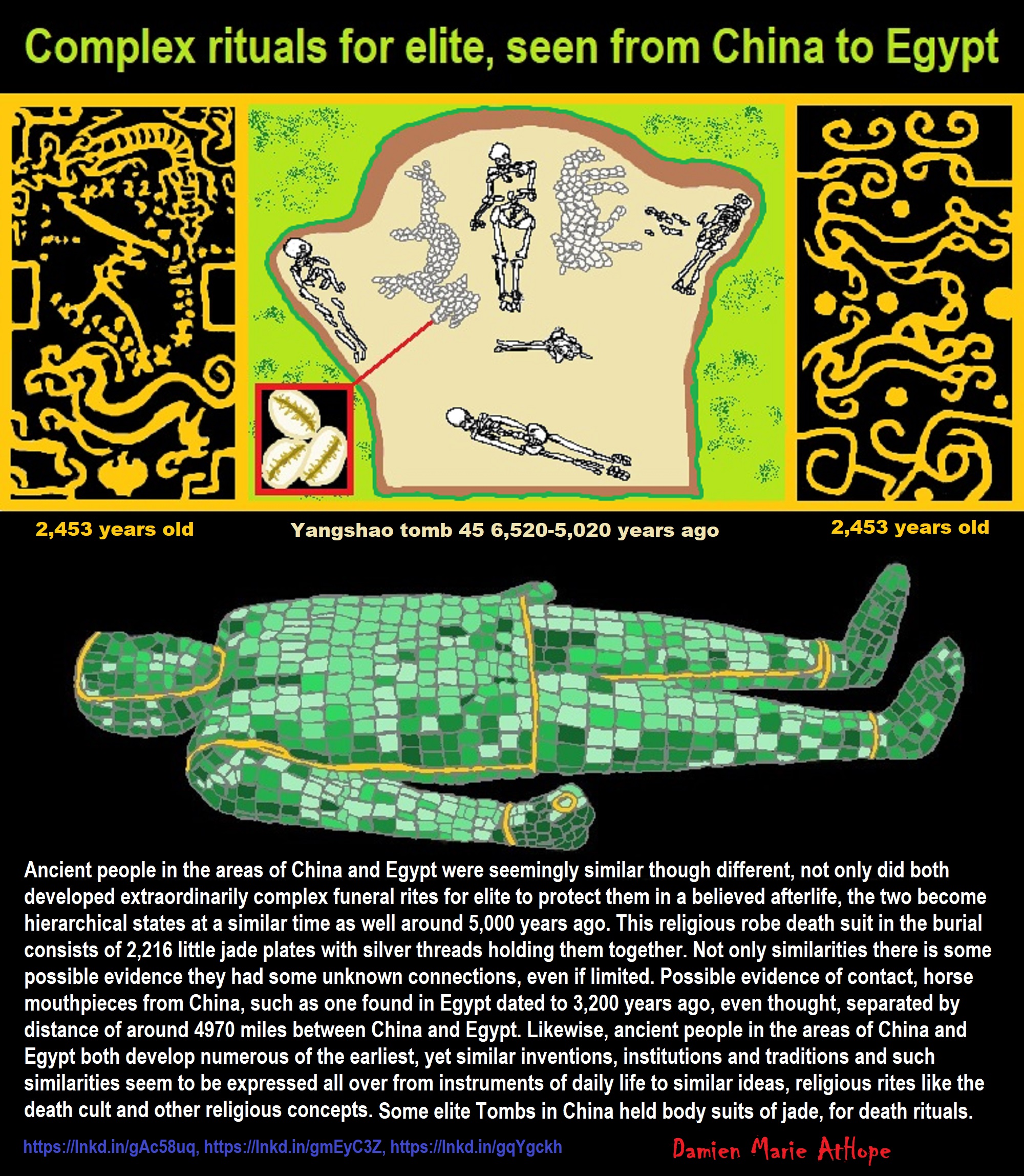
Ancient people in the areas of China and Egypt were seemingly similar though different, not only did both developed extraordinarily complex funeral rites for the elite to protect them in a believed afterlife, the two become hierarchical states at a similar time as well around 5,000 years ago. This religious robe death suit in the burial consists of 2,216 little jade plates with silver threads holding them together. Not only similarities there is some possible evidence they had some unknown connections, even if limited. Possible evidence of contact, horse mouthpieces from China, such as one found in Egypt dated to 3,200 years ago, even though, separated by a distance of around 4970 miles between China and Egypt. Likewise, ancient people in the areas of China and Egypt both develop numerous of the earliest, yet similar inventions, institutions, or traditions, and such similarities seem to be expressed all over from instruments of daily life to similar ideas, religious rites like the death cult and other religious concepts. ref, ref, ref
“Relating to the picture above, not only the Egyptians, the Chinese developed very complex funeral rites in order to protect their dead in the afterword. And the two become hierarchical states at a similar time as well around 5,000 years ago. This religious robe of the royal family was buried consists of 2,216 little jade plates with silver threads holding them together. China and Egypt are also cradles of the World.” ref
“Evidence of possible contact is seen in horse snaffles – a longish mouthpiece made of bronze that is kept flexible by two interlocking rings in the middle enabling the rider to steer the horse to the right or left. One of them was found in Egypt dated to 3,,200 years ago. Seemingly separated by a distance of around 4970 miles between China and Egypt. And yet, these two civilizations seen as the world’s earliest ones, developed numerous similar inventions, institutions, and traditions – not only concerning instruments of daily life, but also religious rites like the death cult and other religious concepts.” ref
“Also, there is the fact that the simple dwellings in China resembled the ones used in Egypt, and in both cultures, people kept dogs. A wide variety of statues, jewelry, ceramics, and cosmetic vessels illustrate the daily life patterns of the societies of both countries. Moreover, both Chinese and Egyptians used pretty much the same type of instruments for washing, a set consisting of a vessel with a handle, and a water bowl. Almost the only thing that differs is how these bronze vessels were decorated.” ref
“What also differs are the materials used by both cultures, as available local raw materials were different. Along with bronze, the Chinese used varnish for their typical luxurious goods. In Egypt, by contrast, this material was not available. That’s why the Egyptians resorted to glass for their luxurious objects, as demonstrate 3,500-year-old bottles of opaque glass that were used to keep oils and perfumes. A comparison between Chinese and Egyptian cultures is particularly interesting when it comes to death cults. As precious burial objects show, both societies developed very complex rites and funeral customs.” ref
Yangshao Culture, Xishuipo Puyang Tomb 45 (M45)
“Yangshao Culture, Xishuipo Puyang Tomb 45 (M45) The discovery in 1987 of a Yangshao culture tomb changed dramatically the willingness of scholars to accept the continuity of traditions from Neolithic to Zhou times. However, just what the artifacts found in Tomb M45 at Puyang, Xishuipo, Henan, which date to between circa 4500 and 3000 BCE, mean has remained uncertain. While K. C. Chang not surprisingly interpreted the arrangement of Tomb M45 to reflect shamanic practices among the Neolithic people who created it, no particular evidence supports or even suggests this interpretation.” ref
“On the other hand, Feng Shi and others have argued that this tomb configuration represents certain asterisms. In fact, it appears that the burial was situated in a way that mirrored certain circumpolar and non-circumpolar asterisms. Four human bodies lie in the tomb that is shaped overall like a turtle plastron, while the center skeleton, that of a young man, represents the “owner” of the tomb. At least one of the other bodies, prior to being interred in the tomb, had been sacrificed or otherwise killed with blade applied to the throat. The owner’s head faces south and his feet north, and at each of his sides lies an animal figure, head positioned toward the north and lying at the feet of the grave owner. The animal figures were constructed from cowrie shells. The figures appear to be guarding the tomb owner. Strikingly, they very obviously take the forms of a dragon and a tiger.” ref
“In the earliest reports of this tomb, its artifacts were dated to 4500 BC. Since then, some question has arisen as to the reliability of this date for human remains in the tomb accompanying the grave owner. However, this seems not to call into question the date of the central figure, i.e., the grave owner, and the cowrie shell animal figures surrounding him. At any rate, the tomb’s artifacts confirmably date to between 4500 and 3000 BCE. On the apparent Neolithic post-interment disruption of M45, see David N. Keightley, “Neolithic and Shang,” in Journal of Asian Studies 54.1 (Feb. 1995): 130.” ref
Yangshao tomb 45 (M45) unearthed at Puyang M45, Henan. From Feng Shi (1990.3:53).
“It is well known that during and after the Warring States period the dragon and tiger became spirit protectors / mythical creatures of the directions of east and west, respectively. Indeed, by as early as the 5th century BC their respective positions and apparent roles as helper spirits (shen 神) were already established: on a lacquer clothes chest dating to 433 BCE and found in the tomb of Marquis Yi of Zeng in Hubei province the dragon and tiger appear in precisely the same arrangement surrounding the pole star as they do in M45 at Puyang. Side pictures are: Pole, dragon, tiger, Dipper, and celestial lodges depicted on a 5th (c. 433) BCE lacquer.” ref
Zhongguo shehui kexueyuan kaogu yanjiusuo, ed., Zenghou yi mu 曾侯乙墓 (Beijing: Wenwu, 1989): 356 (Fig. 216).
That the design adorning the chest represents the northern celestial polar region of the night sky is certain from the fact that surrounding the figures on the side of the box are the Chinese characters for the names of the twenty-eight mansions into which the sky was divided in later Chinese astronomy / astrology. The Dipper also appears near the center (pole) of the diagram. The only difference between the Puyang dragon and that on the marquis’ box is that in the latter the dragon is distinct from the Dipper, while in the Puyang grave the dragon is formed from the Dipper (see text and Figure 2, below). clothes box recovered from the tomb of Marquis Yi of Zeng. From Zenghouyi Mu (1989): 356.” ref
“In Han and later correlative cosmology, and therefore in traditions of internal alchemy, as well, the dragon and tiger, together with the tortoise / snake (north) and vermilion bird / phoenix (south), became the Four Spirits (si shen 四神) of the four directions. In fact, yet another of the later Four Spirits seems to lie in tomb M45, in a position directly north of the owner’s feet. This figure, consisting of a head and stem, is constructed of cowrie shells (head) placed in contact with two human femirs (stem) taken from another skeleton interred nearby. (Figure 1) Feng Shi has proffered that this figure represents the Northern Dipper (beidou 北斗), which, as we know, in the West forms the body and neck of Ursa Major, the Great Bear constellation. Since between c. 4500 and 3000 BCE, the Dipper lay very close to the northern stellar pole, Feng Shi believes that this figure in the grave then represents the pole as embodied in the asterism of the Dipper.” ref
“However, this figure, which is laid out very purposefully north of the feet of the tomb owner’s skeleton to communicate meaning, looks nothing like the Northern (or Big) Dipper. It resembles more a spear and head of broccoli, or, considering later Four Spirit traditions associated with the dragon, tiger, tortoise, and bird, bird plumage. The head or plumage is formed from the Western constellation Auriga, while the stem correlates with the Western constellation Gemini. These arrangements are shown.” ref
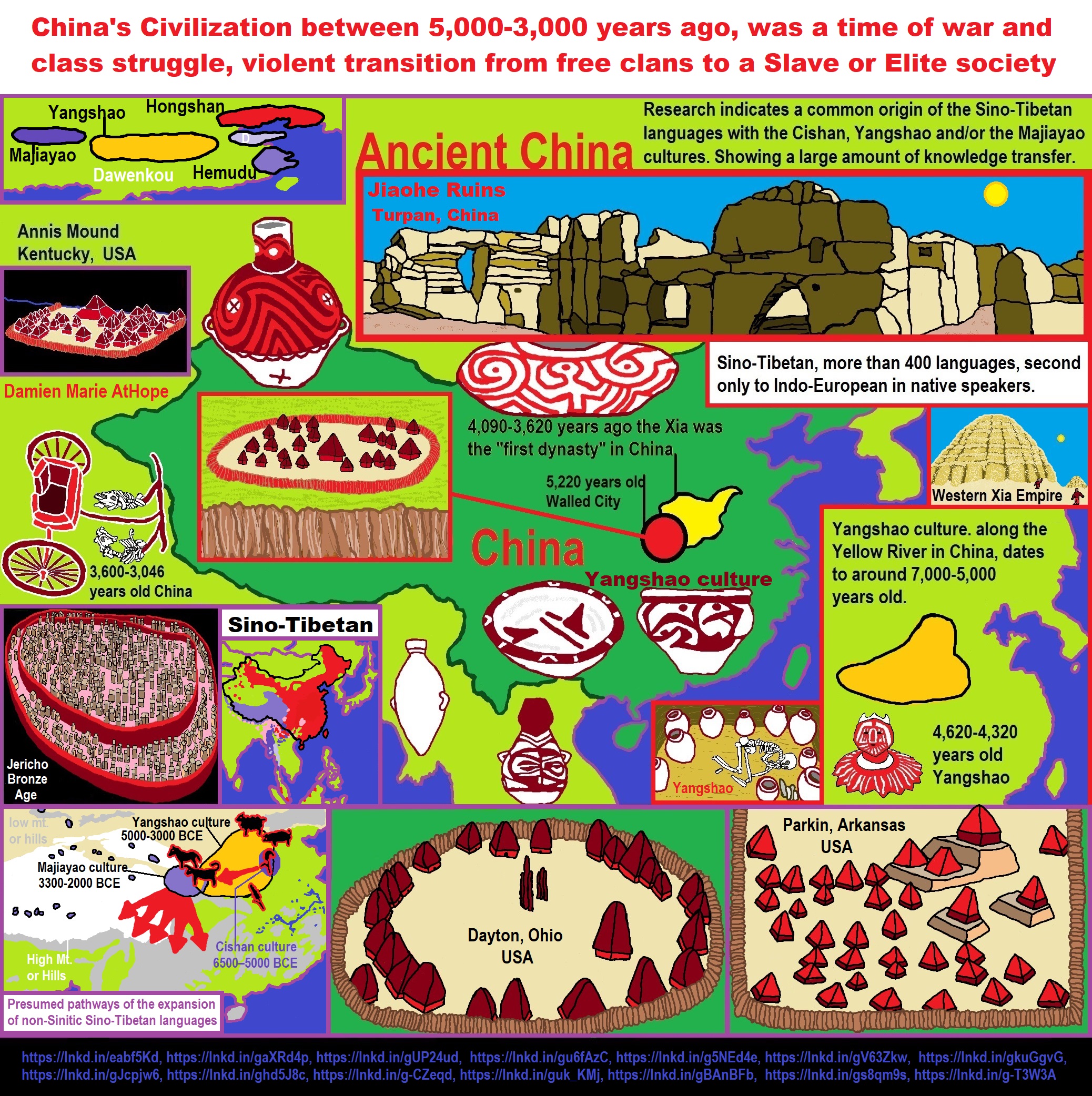
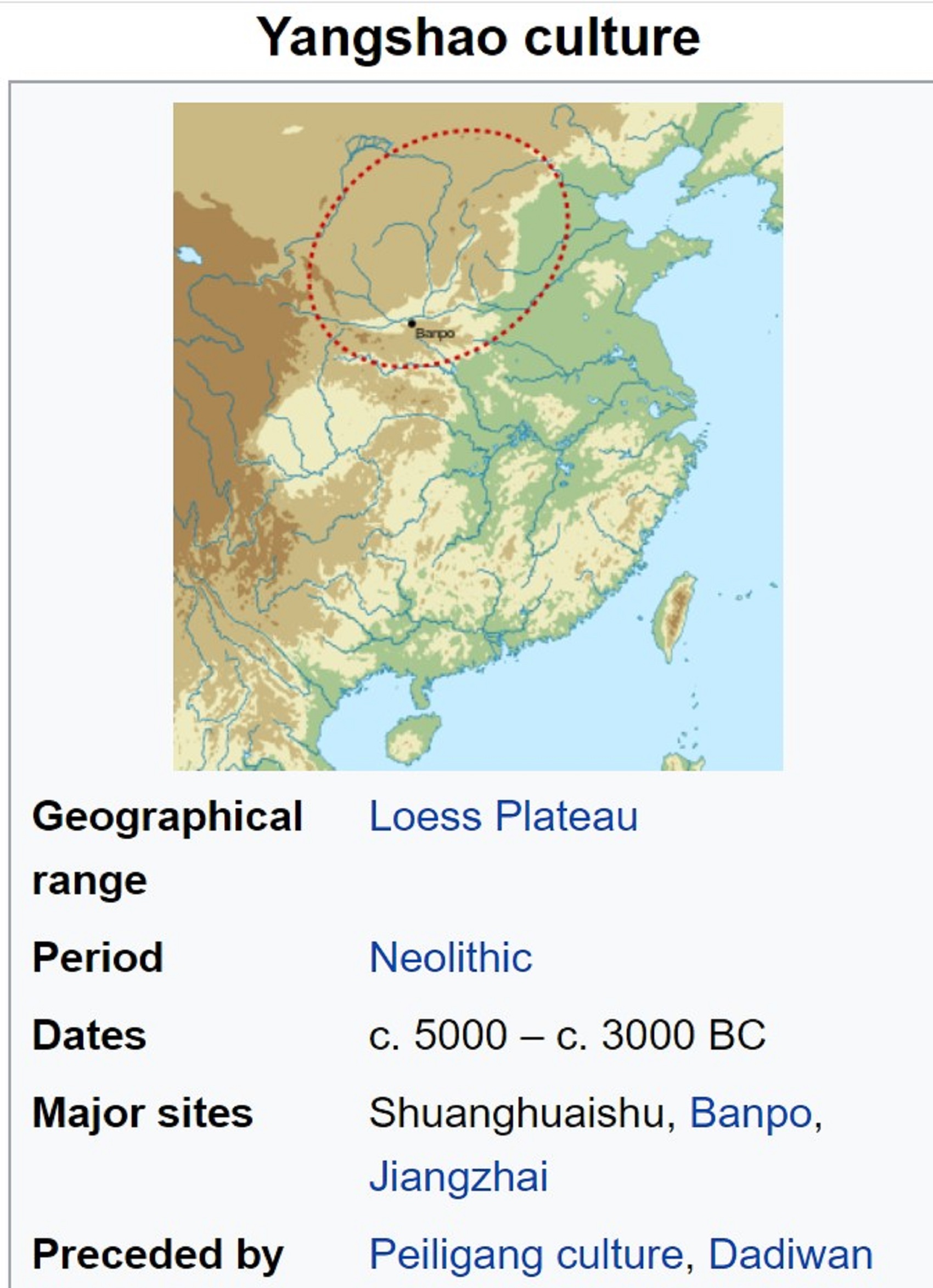
Pic ref
Yangshao culture
“The Yangshao culture was a Neolithic culture that existed extensively along the Yellow River in China. It is dated from around 5000 to 3000 BCE or 7,020-5,020 years ago. The culture flourished mainly in the provinces of Henan, Shaanxi, and Shanxi. Recent research indicates a common origin of the Sino-Tibetan languages with the Cishan, Yangshao, and/or the Majiayao cultures.” ref
“The main food of the Yangshao people was millet, with some sites using foxtail millet and others proso millet, though some evidence of rice has been found. The exact nature of Yangshao agriculture, small-scale slash-and-burn cultivation versus intensive agriculture in permanent fields, is currently a matter of debate. Once the soil was exhausted, residents picked up their belongings, moved to new lands, and constructed new villages. However, Middle Yangshao settlements such as Jiangzhi contain raised-floor buildings that may have been used for the storage of surplus grains. Grinding stones for making flour were also found.” ref
“The Yangshao people kept pigs and dogs. Sheep, goats, and cattle are found much more rarely. Much of their meat came from hunting and fishing with stone tools. Their stone tools were polished and highly specialized. They may also have practiced an early form of sericulture. One item found was a human-faced fish decoration bowl, 5000–4000 BCE or 7,020-6,020 years ago, Banpo village, Shaanxi. The Yangshao culture crafted pottery. Yangshao artisans created fine white, red, and black painted pottery with human facial, animal, and geometric designs. Unlike the later Longshan culture, the Yangshao culture did not use pottery wheels in pottery-making. Excavations found that children were buried in painted pottery jars. The Yangshao culture produced silk to a small degree and wove hemp. Men wore loin clothes and tied their hair in a top knot. Women wrapped a length of cloth around themselves and tied their hair in a bun.” ref
“Houses were built by digging a rounded rectangular pit a few feet deep. Then they were rammed, and a lattice of wattle was woven over it. Then it was plastered with mud. The floor was also rammed down. Next, a few short wattle poles would be placed around the top of the pit, and more wattle would be woven to it. It was plastered with mud, and a framework of poles would be placed to make a cone shape for the roof. Poles would be added to support the roof. It was then thatched with millet stalks. There was little furniture; a shallow fireplace in the middle with a stool, a bench along the wall, and a bed of cloth. Food and items were placed or hung against the walls. A pen would be built outside for animals. Yangshao villages typically covered ten to fourteen acres and were composed of houses around a central square.” ref
“Although early reports suggested a matriarchal culture, others argue that it was a society in transition from matriarchy to patriarchy, while still others believe it to have been patriarchal. The debate hinges on differing interpretations of burial practices. The discovery of a dragon statue dating back to the fifth millennium BC in the Yangshao culture makes it the world’s oldest known dragon depiction, and the Han Chinese continue to worship dragons to this day.” ref
The Yangshao culture is conventionally divided into three phases:
- “The early period or Banpo phase, c. 5000–4000 BCE) is represented by the Banpo, Jiangzhai, Beishouling, and Dadiwan sites in the Wei River valley in Shaanxi.
- The middle period or Miaodigou phase, c. 4000–3500 BCE) saw an expansion of the culture in all directions, and the development of hierarchies of settlements in some areas, such as western Henan.
- The late period (c. 3500–3000 BCE) saw a greater spread of settlement hierarchies. The first wall of rammed earth in China was built around the settlement of Xishan (25 ha) in central Henan (near modern Zhengzhou).
- The Majiayao culture (c. 3300–2000 BCE) to the west is now considered a separate culture that developed from the middle Yangshao culture through an intermediate Shilingxia phase.” ref
· List of Neolithic cultures of China
· Beifudi
· Xishuipo
List of Neolithic cultures of China
“This is a list of Neolithic cultures of China that have been unearthed by archaeologists. They are sorted in chronological order from earliest to latest and are followed by a schematic visualization of these cultures. It would seem that the definition of Neolithic in China is undergoing changes. The discovery in 2012 of pottery about 20,000 years BCE indicates that this measure alone can no longer be used to define the period. It will fall to the more difficult task of determining when cereal domestication started. These cultures are brought together schematically for the period 8500 to 1500 BCE. Neolithic cultures remain unmarked and Bronze Age cultures (from 2000 BCE).” ref
There are many differences in opinion by dating these cultures, so the dates chosen here are tentative:
“18000–7000 Xianren Cave culture (Paleolithic) Wannian County, Shangrao, Jiangxi China
8500–7700 Nanzhuangtou culture Yellow River region in southern Hebei China
7500–6100 Pengtoushan culture central Yangtze region in northwestern Hunan China
7000–5000 Peiligang culture Yi-Luo river basin valley in Henan China
6500–5500 Houli culture Shandong China
6200–5400 Xinglongwa culture Inner Mongolia–Liaoning border China
6000–5000 Kuahuqiao culture Zhejiang China
6000–5500 Cishan culture southern Hebei China
5800–5400 Dadiwan culture Gansu and western Shaanxi China
5500–4800 Xinle culture lower Liao River on the Liaodong Peninsula China
5400–4500 Zhaobaogou culture Luan River valley in Inner Mongolia and northern Hebei China
5300–4100 Beixin culture Shandong China
5000–4500 Hemudu culture Yuyao and Zhoushan, Zhejiang China
5000–3000 Daxi culture Three Gorges region China
5000–3000 Majiabang culture Lake Tai area and north of Hangzhou Bay China
5000–3000 Yangshao culture Henan, Shaanxi, and Shanxi China
4700–2900 Hongshan culture Inner Mongolia, Liaoning, and Hebei China
4100–2600 Dawenkou culture Shandong, Anhui, Henan, and Jiangsu China
3800–3300 Songze culture Lake Tai area China
3400–2250 Liangzhu culture Yangtze River Delta China
3100–2700 Majiayao culture upper Yellow River region in Gansu and Qinghai China
3100–2700 Qujialing culture middle Yangtze region in Hubei and Hunan China
3000–2000 Longshan culture central and lower Yellow River China
2800–2000 Baodun culture Chengdu Plain China
2500–2000 Shijiahe culture middle Yangtze region in Hubei China
1900–1500 Yueshi culture lower Yellow River region in Shandong China” ref
Location of Neolithic sites related to beer brewing in China.
“Is the globular shape of the jars found in China at sites from the early Neolithic period related to beer brewing? The same question applies to archaic amphorae and more recent finds at Neolithic sites in China.” ref
- “The beers are brewed with all starchy plants, cereals (millet, rice) but also tubers, beans, and starchy fruits.
- Two brewing methods coexist beer ferments and the malting of grains, mainly millet.” ref
“This increasingly concordant information gathered on beer brewing in the Neolithic period covers a relatively long Neolithic period, between 7000 and 3000 BCE. They raise a new question. Do the shape and size of the jars and amphorae used to brew and store beer have anything to do with brewing methods and a more intensive consumption of beer from 4500 BCE onwards? To corroborate this analysis, two sets of research are being undertaken by Li Liu’s team.” ref
“In 2019, they confirm that the globe-shaped jars discovered at many Neolithic sites are indeed used to brew beer with the two brewing methods already identified in 2016: beer ferments and grain malting. These globular jars predate the pointed-bottom amphorae called jiandiping which were used between 4000 and 2500 BCE to brew beer in the same area of the middle Huang-He basin and the Wei river.” ref
“In 2020, the investigation covers the period 5000-4000 BCE to fill a chronological gap between the ancient globular jars (Jiahu, ancient Neolithic of Yangshao, between 7000 and 5000 BCE) and the large jiandiping pointed-bottom jars that appeared around 4000 BCE. The analysis confirms that these ancient Banpo-type amphorae were also used to brew beer.” ref
“In summary, Li Liu’s researches restore a complete chronological sequence for the Neolithic and the brewing of beer in the Huang-He region. It ranges from Jiahu (≈6000 BCE) to the recent sites of Mijiaya/Xinjie, Dingcun, and Yangguanzhai (4000-3000 BCE) and runs through an intermediate period (Banpo IV) with the use of the ancient beer amphorae.” ref
The globular jars of Lingkou and Guantaoyuan (2019).
‘Two new Neolithic sites about 300 km apart were tested: Lingkou (Lintong District) and Guantaoyuan (Baoji district), both near the Wei River in Shaanxi (see map). The samples analyzed for Lingkou and Guantaoyuan date respectively from 5900-5000 BCE and 5800-4900 BCE, the Early Neolithic period in this region of China. Namely 3 shards of globular jars and 3 shards of tripods for Lingkou, 14 shards (jars, bowls, tripods, perforated basin), and millstones for Guantaoyuan. The plants used to brew beer are those already identified in Mijiaya and Dingcun, and in addition beans and ginger.” ref
“Lingkou borders two rivers, while Guantaoyuan lies on a high terrace. This difference may explain the presence of rice in Lingkou and its absence in Guantaoyuan, conversely the presence of starchy roots (lily bulbs, yam) only in Guantaoyuan. Variable starch resources may explain the different brewing methods that emerge from the analysis of the microorganisms.” ref
Two brewing methods :
“In Lingkou, the structure and distortions of the starch granules involves germination and fermentation, two hints to the brewing with millet malt. Phytoliths that come mainly from the husks of millet or rice grains show that the whole grains have been brewed, probably after germination. This means that we are dealing mainly with a brewing using malted millets.” ref
“In Guantaoyuan, the brews contain more leaf and root phytoliths. The presence of two amylolytic fungi, Rhizopus and Aspergillus oryzae, indicates the use of beer ferments for the Guantaoyuan site only. The presence of hyphae and sporangia implies that these strains of fungi have developed during the manufacture of ferments under favorable conditions of temperature, humidity, and nutrients. We are dealing with a (spontaneous or controlled) culture of amylolytic fungi.” ref
“Once these two brewing methods have been identified and dated, the question arises as to how they relate to the shape of the jars and pots clearly used for beer making. The oldest vessels are globular in shape. They have been found at many sites and roughly cover the period between 7000 and 5000 BCE.” ref
“From 4000 BCE, a new vessel shape appears: the jar with a pointed bottom, the amphora called jiandiping. This amphora is associated with the funnel and the multi-perforated terracotta cooker. This brewing kit is developed throughout the Yangshao culture, between 4000 and 3000 BCE. During this period, the amphoras slowly increase in size until they reach almost 1 m high (0.87 cm avg.). This can be interpreted as an indication of increasing beer consumption and ceremonies involving ever larger groups. The proportion of grains taken from the harvest to brew beer is also increasing, in line with the expansion of agriculture. The improvement of brewing techniques and tools is a phenomenon linked to the emergence of social hierarchies.” ref
Is it possible to analyze the function of beer jars and amphorae?
“The globular jar with its more or less narrow neck is an ideal container for the germination of grains and the fermentation of a semi-solid mass of grains, the latter technique corresponding to the use of beer ferments. Its use is technically very wide: from cooking soups to the fermentation of more or less thick groats. However, its narrow opening allows an easy and efficient closing, which is suitable for liquids that need to be isolated from the air, not necessarily for open-pot cooking.” ref
“The later amphora jiandiping is also more specialized. It is suitable for liquids. Its pointed bottom implies that it is semi-buried and upright. Its height favors the convection of liquids under the effect of the temperature gradient between the bottom and the neck. It is the ideal jar for the fermentation of liquids, for beer brewed by infusion of a mixture of malted grains and roots or tubers rich in starch. The same remark applies about its easy closure thanks to the long, narrow neck.” ref
Archaic amphorae for brewing beer (2020).
“Between 5000 and 4000 BCE, an amphora with a more archaic shape predates the pointed amphora jiandiping. Of stocky shape, with a pointed bottom and narrow neck with a cup-shaped mouth, often with two lateral handles, it also belongs to the Neolithic culture of Yangshao. Li Liu’s team analyzed 11 amphorae of this type exhumed from the two sites of Banpo and Jiangzhai, in tombs or dwellings.” ref
“The results cross-check and confirm the data already obtained on other archaeological sites in the region. These amphorae were used to brew beer with two competing or complementary brewing methods. These amphorae were usually interpreted as jars for drawing, storing, or transporting water. The scientific analyses of Li Liu and his colleagues upset this opinion. Brewing beer needs water. But the main use of these amphorae was the preparation of beer. These amphoras filled all the stages of the brewing process: fermentation (amphora shape), storage (pointed bottom, semi-buried amphora), serving the beer (neck shape), and finally fermented drink offerings (amphoras found in graves or recycled as funeral urns).” ref
“Switching from water to beer is not insignificant when one wants to understand the way of life of human groups in the Neolithic period. Alongside hunting and fishing, the fermented drinks made from cereals, tubers, and starchy fruits became more and more important in their lives. The social role of beer grows. Its symbolic role is built up as indicated by funeral offerings.” ref
“These latest discoveries bridge the 1000 year gap between the Early Neolithic and Late Neolithic of Yangshao. This is a substantial and magnificent achievement. The proto-history of Chinese brewing is now documented over 4 millennia, between 7000 and 3000 BCE, for the middle Huang-He basin. This long chronological sequence is the first such complete timeline about brewing for such an ancient period achieved in the world. Similar and extensive research in the Yangtze basin may reveal surprises in one area where rice and tubers were the staple foods, not millet.” ref
‘Analytical methods can be refined to characterize other brewing methods such as insalivation or amylolytic plants. The action of ptyalin (human saliva) or amylases from plants probably do not leave the same signatures in starch granules.” ref
“The methods of archaeological analysis used in China can be applied in other regions of the world which have a rich protohistory of beer (Middle East, South-East Asia, Central Asia, India, Africa, South & Central America, Europe). A European team has recently proposed a new marker to detect the action of malting on grain residues. It has the comparative advantage of being applicable to very damaged grain residues, even burnt or crushed. It also has a limitation: only the malting method can be identified. Other brewing methods will remain invisible without an analysis of the residues of microscopic fungi.” ref
Is the beer-ferment (qu starter) technique a Chinese invention?
“It is not certain that the beer-ferments method (also called qu starter following the late litterary traditon) is a Chinese invention if by “Chinese” we mean the Yellow River region 7000 years ago. This is the oldest dating provided by the Lingkou and Guantoyuan sites. Indeed a remarkable result in its own.” ref
“The concept of invention is inappropriate when applied to food technology. The origin of beer ferments is undoubtedly complex because it stems from prehistory during which all fermented drinks were combined. At the time of Jiahu, beer stricto sensu was not yet born. Fermented beverages from starch (beers) has not yet separated from the common core of alcoholic beverages, which are at the same time and all together technically mead, beer, and wine. The prehistoric foundation of undifferentiated fermented drinks is shared by all Asian human groups. The technique of beer fermentation may have been developed in Central Asia, for example, and then brought to the Yellow River basin by non-sinised populations. In this field, the quest for “inventors” or for the craddle of origins is illusory.” ref
‘On the other hand, the technique of beer ferments is known in parts of the world in protohistoric times where contacts with central China have yet to be proven. Indian brewers in the Indus and Ganges basins used beer ferments kinva more than 3500 years ago. The Native Americans of the Caribbean are familiar with this technique for brewing sweet potato beer (mabi). It is documented for the modern period (16-17th centuries), however certainly older, without assuming a Chinese influence. At that time, only the maritime route of the Manila Galleon connects Central America and the Philippines.” ref
‘The beer ferment bubod in the Philippines could have been borrowed from Chinese brewing techniques. It would be necessary to prove it and especially to specify the chronology. Under the Ming, Admiral Zheng He’s account of his maritime journeys contains numerous references to the brewing peoples of the Southern Seas (Java, Sumatra). These journeys undertaken between 1405 and 1433 are too late to deduce from them borrowings of brewing methods from southern China in much older times.” ref
“In short, beer ferments are known and used by all Asian peoples, from India to Japan, from China to Java. A brewing technique used over such a vast geographical area can hardly originate from a single source, as old as it may be.” ref
The brewing function of the first amphorae in the Neolithic Yangshao culture, North China
Abstract
“In recent years, functional study of Neolithic pottery found in the Yellow River valley has shown that globular jars of the pre-Yangshao period (ca. 7000–5000 cal. BCE) and jiandiping amphorae of the middle and late Yangshao period (ca. 4000–2900 cal. BCE) were alcohol fermentation vessels. However, there is a time gap of 1000 years (ca. 5000–4000 cal. BCE) between these two sets of vessels, namely the Early Yangshao period when amphorae first appeared. In order to further our understanding of alcohol production in Neolithic China, we employed scientific methods to examine microfossil remains in the residues adhering to the interior walls of eleven among the earliest amphorae from the Banpo and Jiangzhai sites in Shaanxi province. Multiple lines of evidence—taken from starch granules, phytoliths, molds, yeast cells, and rod-shaped calcite crystals found in the residues—indicate that these amphorae were used for brewing alcoholic beverages. The ingredients mainly include broomcorn millet, together with other cereals (foxtail millet, rice, and Triticeae), wild peas, and tubers (snake gourd roots and foxnut). Two brewing methods have been detected: use of sprouted grain and use of qu starter made of moldy grain with herbs. Siphoning through reed straws may have been one of the drinking methods. The results of this research open a new window not only for understanding the long tradition of alcohol production in prehistoric China, but also for investigating alcohol-related social activities of the Yangshao people.” ref
Reasons for the Wide Spread of the Protosyllable -*kam- (and Its Phonetic Variants -*kham-, -*cham-) in the Modern Place-Names (Multidisciplinary Approach) DNA-Genealogy Data Relevant to the Linguistic Study: Archaeological Data Revealing the Common Eurasian Cult since the Paleolithic
Evidence of Unified Religious Cult Spread in the Neolithic Age on the Territory of Eurasia, Japan, and America (Heart-Like Images of the Face of the Great Goddess), Proceedings of the Academy of DNA Genealogy, 2013
They forged mighty weapons and traded across the Eurasian steppe — yet their true identity remains a mystery. Meet the progenitors of China’s Bronze Age.
“Sometime around 4000 BCE — when Egypt and Sumer were just beginning to build their first cities — a few hundred nomads gathered on the banks of China’s northwest Yellow River Valley, near what would someday be the border of Mongolia. These were not wealthy urbanites accustomed to luxury, like the nobles who lived at Jiahu 2,000 years earlier. No, these nomads wore rough-spun hemp — and trudged through the marshes trailed by hunting dogs and pigs, hefting heavy sacks of grain on their backs. For some reason, the people decided they liked this new place. They set to work harvesting wild millet from the riverbanks, ground its grain into flour, and wove its stalks into the walls and roofs of their houses — just as they’d done in countless other places across northwestern China, for untold centuries.” ref
But the people who settled at Yangshao decided this place was different from the others. They chose to stay and build a permanent life here.
“Around a central square, they built not only rings of traditional houses, but also storage buildings for surplus grain. They raised other large buildings too — which may have been administrative centers, or even proto-mansions for an emerging upper class. And encircling the entire village — a site of some 14 acres — the people dug a deep trench, and filled it with rammed earth until they’d built a wall sturdy enough to keep out all intruders. Within that wall they kept pigs and dogs for food — and later took to raising sheep and cattle.” ref
In short, these people were gradually making the shift from a nomadic pastoralist (hunting-and-herding) way of life to a fully settled agricultural lifestyle. Why did these cultural changes happen here at Yangshao, at this particular time — and not in the hundreds of other places these nomads broke camp?
“Some archaeologists believe this site may have proven unusually fertile, enabling the people to shift from slash-and-burn cultivation to more planned, sustainable agriculture. Others have suggested the population was simply getting too large to keep moving. And it’s undeniable that Yangshao’s population was quite large for a settlement of this period. This fact hints that grain production would have had to be similarly upscaled — so it’s no surprise that we find a new innovation here: centralized storage buildings, large enough to hold grain for several hundred people, along with their livestock. Other researchers — still more controversially — suggest that Yangshao may have marked a shift from matriarchy to patriarchy. For here we find burials of unprecedented size and richness: graves filled with delicately patterned pottery, stone weapons, and tools — and the oldest known dragon engraving in Chinese prehistory.” ref
The earliest stage of Yangshao culture — known as the Banpo phase — evolved fairly seamlessly into its subsequent Majiayao phase around 3,000 BCE.
“The transition from Banpo to Majiayao was marked not so much by disruption as by development. Millet production became more organized, as slash-and-burn agriculture gave way to widespread irrigation and systematic field cultivation. As growing food stores supported larger populations, a class of artisans and craftspeople began to emerge in larger towns, such as Baidaogouping and Dongxiang. These specialists created elegant pottery in centralized workshops. Production became so “automated,” in fact, that the cost of the finest pottery dropped sharply — a fact attested by the widespread presence of elaborately painted clay vessels even in ordinary burials of this period.” ref
Majiayao artisans also forged the first bronze weapons in China — inaugurating a swordsmithing tradition that has survived all the way to the present day.
“By the 2200s BCE, the Majiayao culture had developed into a phase today known as Qijia, after one of its most famous settlement sites. Although settlement patterns and agriculture changed little in this period, Qijia people raised bronze work to a fine art — and established trade links with Siberia and Central Asia.” ref
But who were the people who built Yangshao, Majiayao, and Qijia? Were they related to those who wove silks and played flutes at Jiahu — or to any modern Chinese group?
“Though theories and speculation abound, the truth is that we just don’t know for sure. Genetic evidence is extremely slim — as are clear archaeological links between these cultures and the first “officially Chinese” dynasties: the Xia and Shang. Many anthropologists believe that the peoples who inhabited these ancient sites may not have been genetically related to one another at all, but may simply have adopted practices and art forms (such as painted pottery) from more “advanced” cultures as they migrated into the Yellow River Valley. One tantalizing possibility is that some of these people may have migrated southeast from Mongolia’s Gobi Desert region sometime between the 5000s and 3000s BCE — bringing genes, languages, beliefs, and practices from Central Asia into China.” ref
Does Yangshao represent a “dark age” after the fall of Jiahu — or was it home to an entirely different people, perhaps more “Mongolian” in their origins and customs?
“Several intriguing pieces of evidence hint that this is at least possible; perhaps even likely. For example, ancient Turko-Mongolic cultures were famous for their strong tendencies toward a nomadic hunting-and-herding way of life — as were the Yangshao people. It’s worth noting that some of the oldest Chinese history texts — such as the “Book of Documents,” composed in the 200s BCE — clearly describe the people of the Xia dynasty as nomadic pastoralists. Although these clans were sometimes ruled by kings in agricultural city-states, the ancient sources make it clear that they often reverted back to their nomadic lifestyle in times of crisis.” ref
Across Central Asia and down into China, these prehistoric peoples practiced strikingly similar lifestyles.
“For example, they harnessed horses to plows and chariots long before they domesticated oxen — precisely the reverse of what happened in ancient Europe and the Middle East. And even as they became more sedentary, these nomads continued to build lightweight circular houses that could be packed up and transported easily.” ref
Material luxuries and weapons provide still more tantalizing links between western China and Central Asia.
“Archaeologists identify many cultures from his period — ranging all the way from Finland, through Russia and Mongolia, down into western China — as belonging to a connected cultural movement, easily recognized by similar bronze knives and arrowheads, as well as their distinctive painted pottery and chariots.” ref
This mysterious movement, known as the Seima-Turbino Phenomenon, began on the open steppe-land of Central Asia, which was always a vast cultural mixing bowl.
‘Just as Scythian horsemen would someday influence cultures as far apart as Greece and India — and, centuries later, the confederation of the Huns would raid empires as distant as China and Rome — the Seima-Turbino movement spread its prehistoric influence from eastern Europe all the way to the Yellow River Valley. In fact, it’s entirely possible that the Yangshao culture’s “trade links” with Central Asia simply represented two fringes of one continuous cultural sphere — a realm of influence that reached as far west as Scandinavia, as far north as Siberia, and as far southeast as China.” ref
Still more evidence for this continuity comes from linguistics: several tongues spoken in ancient western China appear to be related to the Ural-Altaic language family, which reaches as far west as Finland.
“Although modern Chinese is monosyllabic, many languages once spoken in western China — for example, Khitan and Tuyuhun — were polysyllabic and highly agglutinative; as are Mongolian, Turkish, Finnish, and several languages spoken in Siberia to this day. In other words, whereas Mandarin Chinese (and its ancestor languages) form sentences by connecting single-syllable words in customary order, many languages spoken on the Central Asian steppe and along its fringes — such as Mongolian, Turkish, and Finnish — form entire sentences by joining particles of meaning into “super-words.” Take, for example, the simple sentence, “Can I use that?” In English, we can clearly identify the verbs (“can” and “use”) and the pronouns (“I” and “that”). Modern Mandarin Chinese is even simpler: you’d simply say, “Kěyǐ yòng ma?” (可以用吗), which is something like, “Can use?” ref
A notorious example of agglutination from the modern Turkish language
“In a highly agglutinative language like Turkish, on the other hand, we find ourselves in a whole different world: “Kullanabilirmiyim?” This single “super-word” consists of the particles “kullan-” (“to use”), “bilir” (“be able to”), “mi” (“question”), and “yim” (“I / me”) — so we end up with something like, “To use + able to + question + me?” ref
A high degree of agglutination is a trademark feature of the Ural-Altaic languages, which have been spoken for millennia from eastern Europe to western China.
“Distribution of Ural-Altaic languages in Europe, Central Asia, and China But the strongest evidence of all comes from genetics: a distinctive strand of DNA known as “haplogroup N” first appeared among people in Siberia, and later showed up in western China. The migration of DNA haplogroup N, eastward and westward from Siberia.” ref
Does this mean the villagers at Yangshao were more “Siberian” than “Chinese?” As you can see by now, the story is never that simple. For one thing, six thousand years ago there was no such thing as a “Chinese person!”
In those far-distant days — when the very first imperial dynasties still lay thousands of years in the future — the fertile river valleys between the Gobi Desert and the East China Sea were home to dozens of related peoples. While these peoples produced similar crafts, lived similar semi-nomadic lifestyles, and (at least sometimes) spoke related languages, it’s unlikely that they were particularly close genetic relatives — either of one another, or of any ethnic group in modern China.” ref
This is one reason why prehistoric China’s development doesn’t look like linear “advancement” from stone-age villages to bronze-age cities.
“Instead, it looks much more like a patchwork of disparate cultures, practicing a variety of lifestyles — many of which contained elements we can now recognize, from our far-future viewpoint, as essentially “Chinese.” And as we’ll see in the next installment of this series, Yangshao was far from the only great ancient culture to rise in the Yellow River Valley. As primordial China’s bronze age took root, their descendants would encounter new and foreign cultures — which had been perfecting their own ways of life for thousands of years.” ref
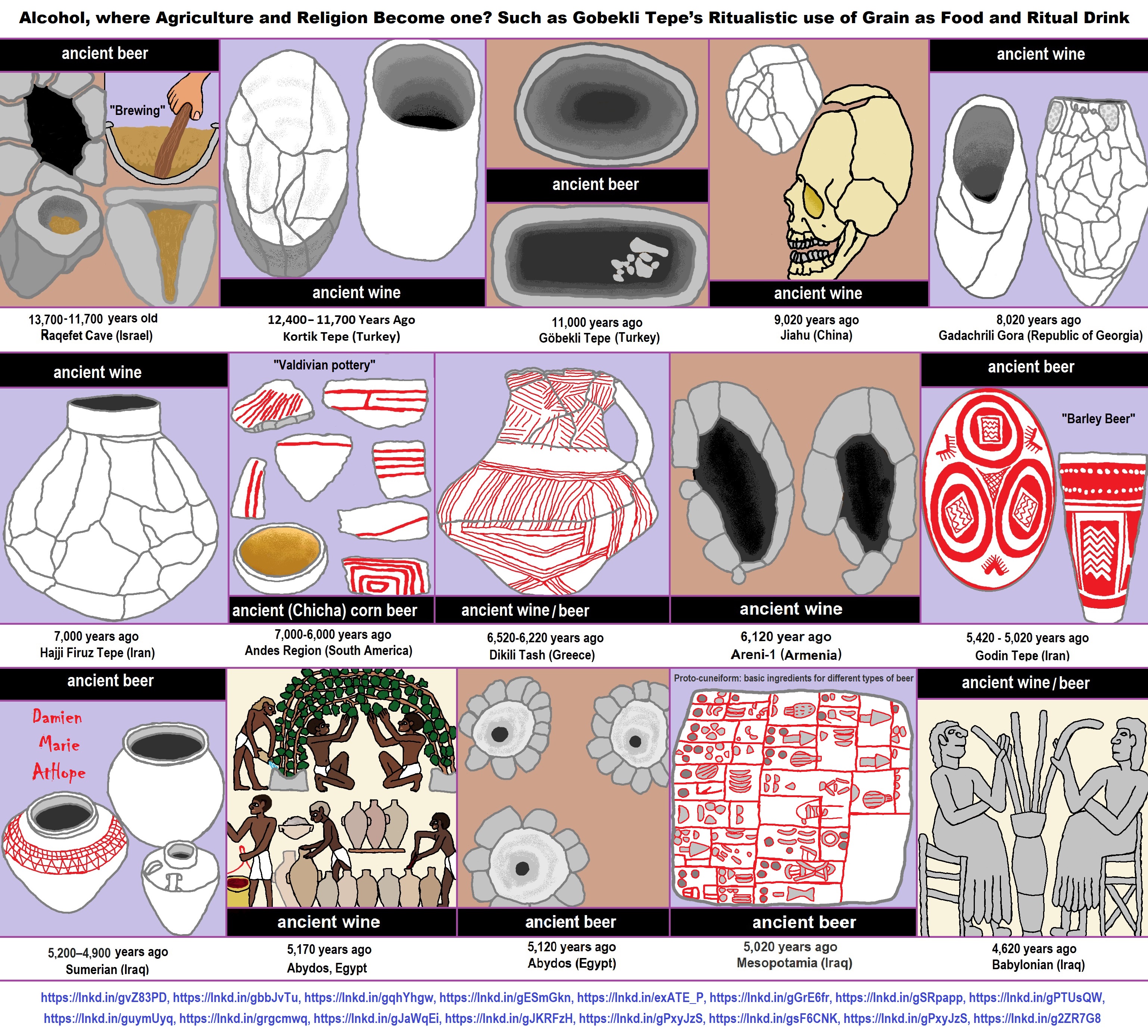
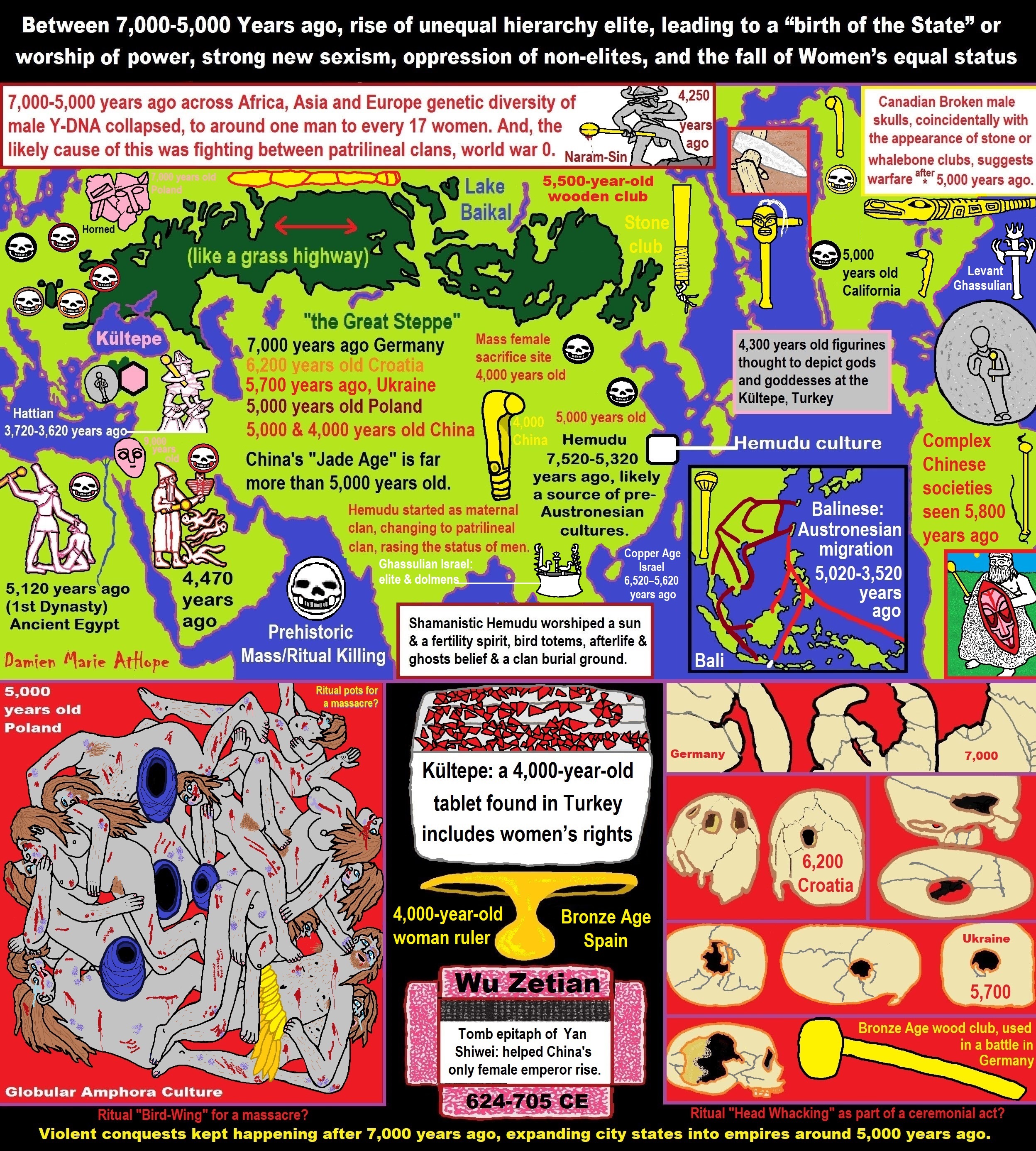
ref, ref, ref, ref, ref, ref, ref, ref, ref, ref, ref, ref, ref, ref, ref, ref, ref, ref, ref, ref, ref, ref, ref, ref, ref, ref, ref, ref, ref, ref, ref, ref, ref, ref, ref, ref, ref, ref, ref, ref, ref, ref, ref, ref, ref, ref, ref, ref, ref, ref, ref, ref, ref, ref, ref, ref, ref, ref, ref, ref, ref, ref, ref, ref, ref, ref, ref, ref, ref, ref, ref, ref, ref, ref, ref, ref, ref, ref, ref, ref, ref, ref, ref, ref, ref, ref, ref, ref, ref, ref
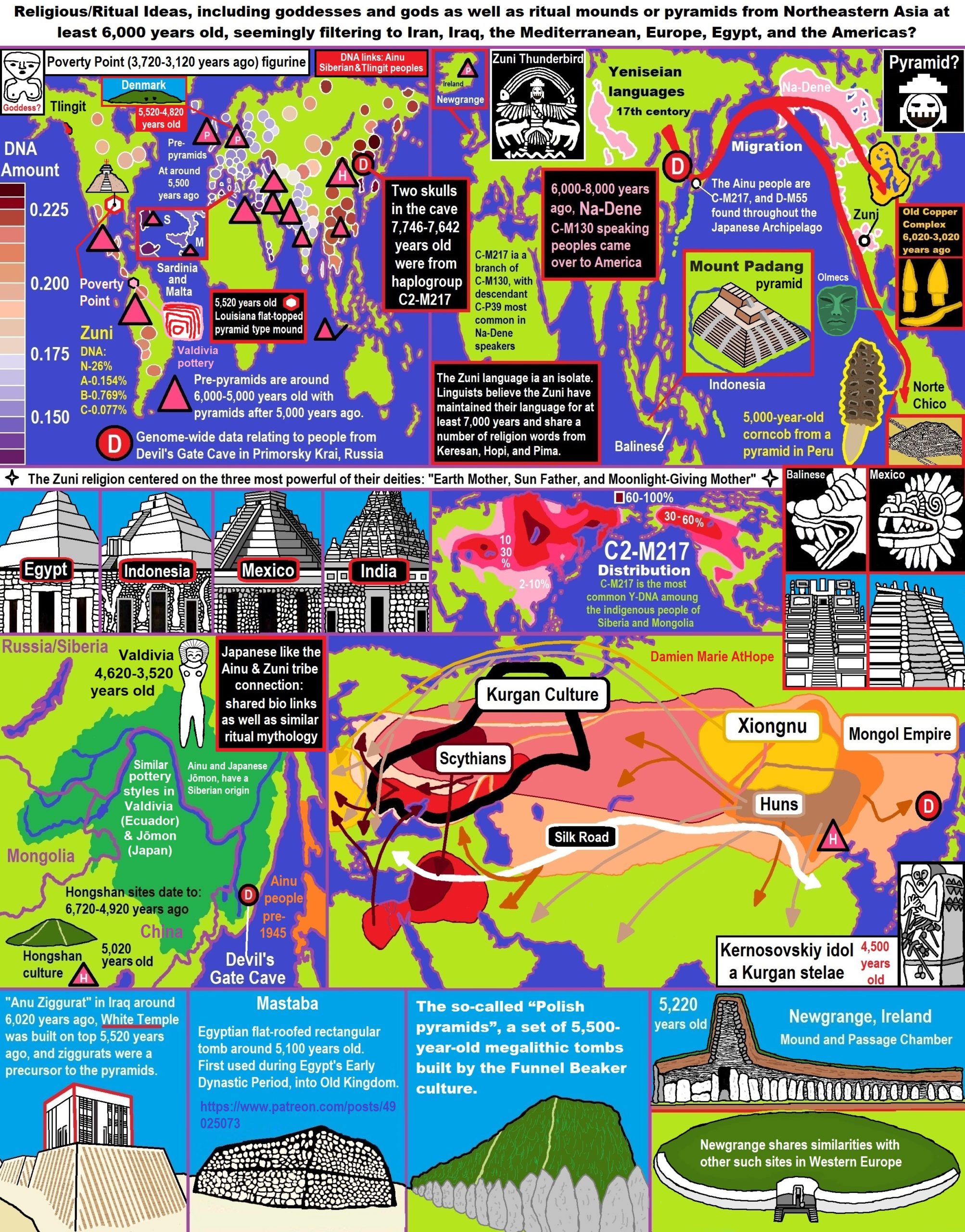
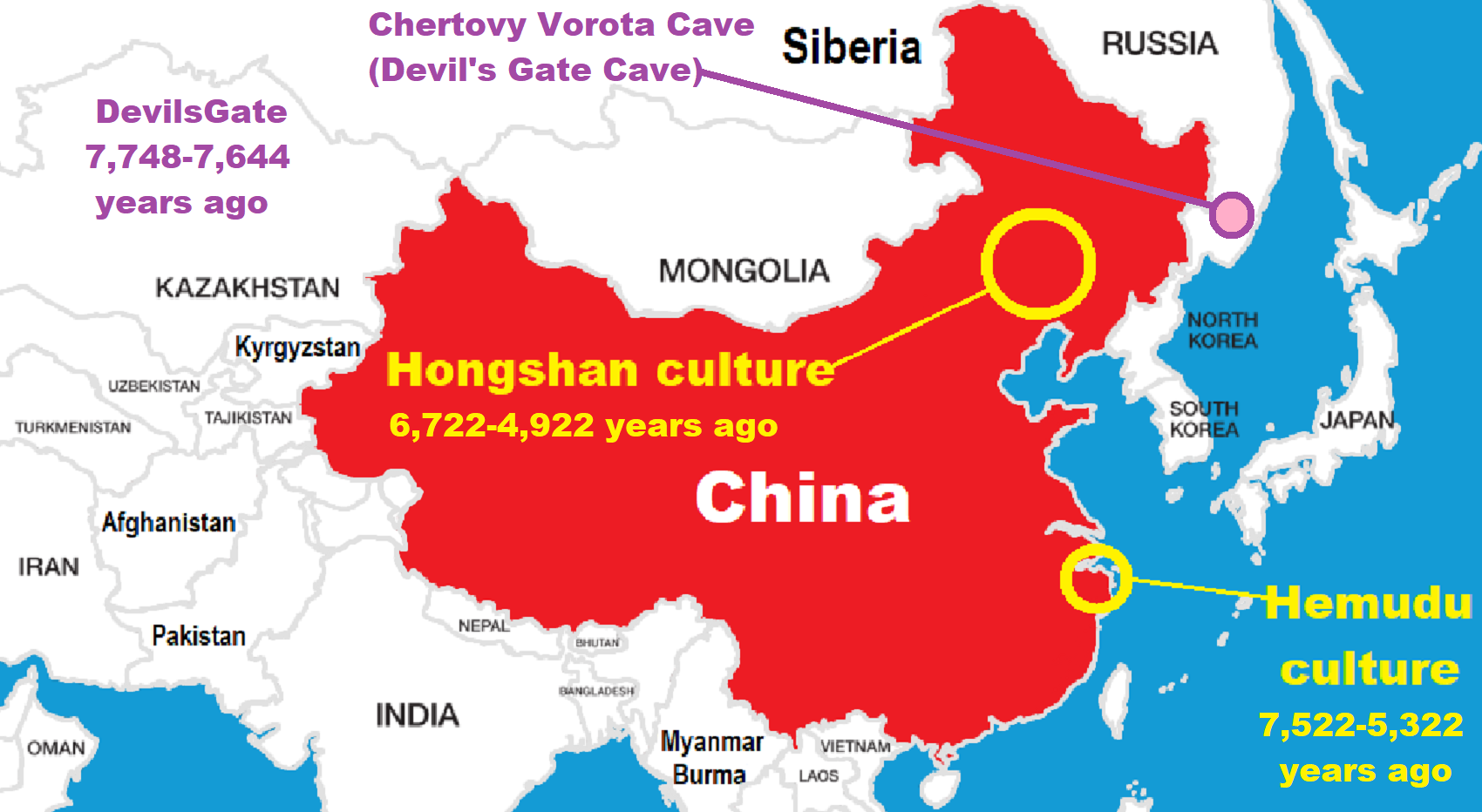

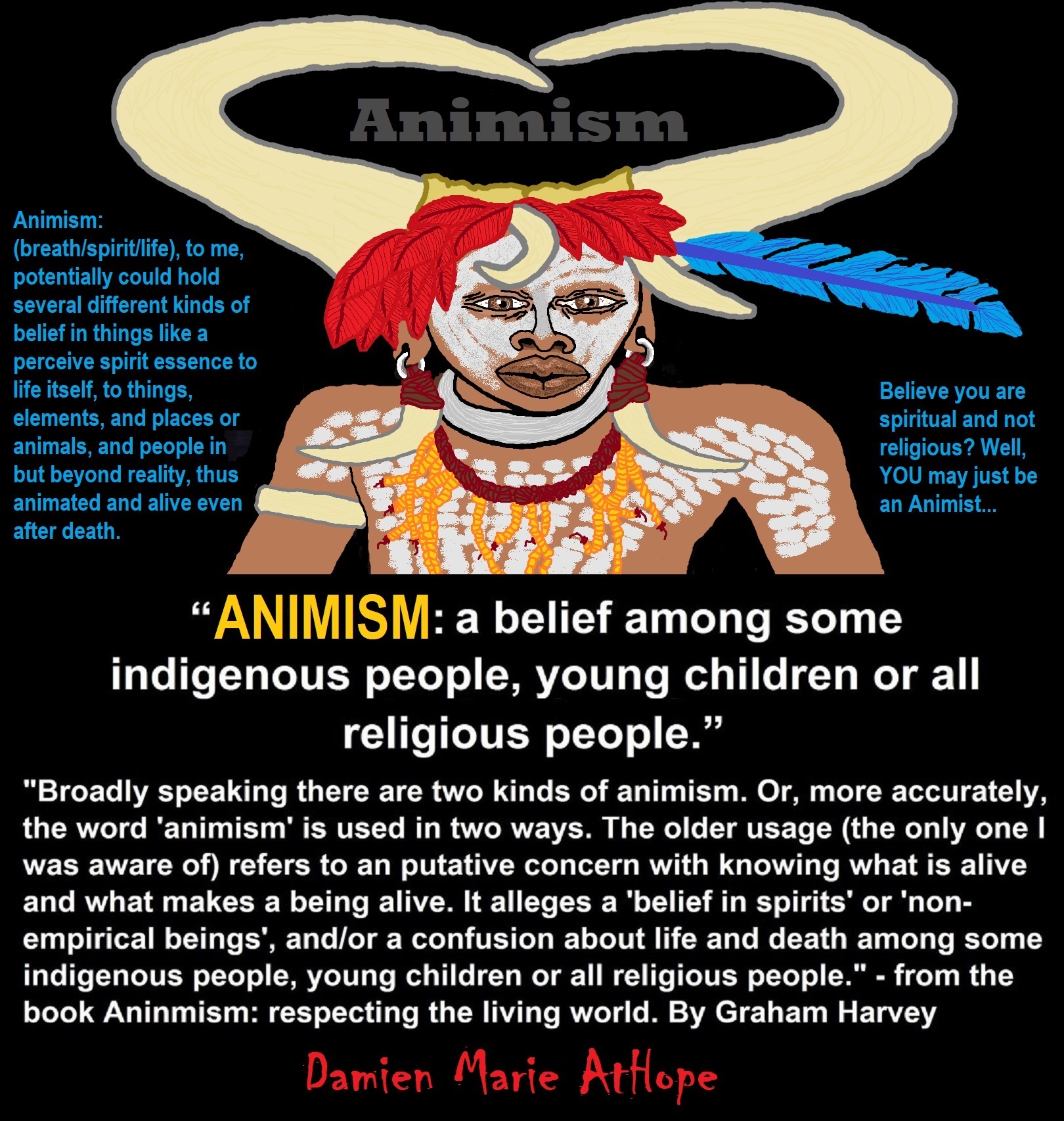
Animism: Respecting the Living World by Graham Harvey
“How have human cultures engaged with and thought about animals, plants, rocks, clouds, and other elements in their natural surroundings? Do animals and other natural objects have a spirit or soul? What is their relationship to humans? In this new study, Graham Harvey explores current and past animistic beliefs and practices of Native Americans, Maori, Aboriginal Australians, and eco-pagans. He considers the varieties of animism found in these cultures as well as their shared desire to live respectfully within larger natural communities. Drawing on his extensive casework, Harvey also considers the linguistic, performative, ecological, and activist implications of these different animisms.” ref

My thoughts on Religion Evolution with external links for more info:
- (Pre-Animism Africa mainly, but also Europe, and Asia at least 300,000 years ago), (Pre-Animism – Oxford Dictionaries)
- (Animism Africa around 100,000 years ago), (Animism – Britannica.com)
- (Totemism Europe around 50,000 years ago), (Totemism – Anthropology)
- (Shamanism Siberia around 30,000 years ago), (Shamanism – Britannica.com)
- (Paganism Turkey around 12,000 years ago), (Paganism – BBC Religion)
- (Progressed Organized Religion “Institutional Religion” Egypt around 5,000 years ago), (Ancient Egyptian Religion – Britannica.com)
- (CURRENT “World” RELIGIONS after 4,000 years ago) (Origin of Major Religions – Sacred Texts)
- (Early Atheistic Doubting at least by 2,600 years ago) (History of Atheism – Wikipedia)
“Religion is an Evolved Product” and Yes, Religion is Like Fear Given Wings…
Atheists talk about gods and religions for the same reason doctors talk about cancer, they are looking for a cure, or a firefighter talks about fires because they burn people and they care to stop them. We atheists too often feel a need to help the victims of mental slavery, held in the bondage that is the false beliefs of gods and the conspiracy theories of reality found in religions.
Understanding Religion Evolution:
- Pre-Animism (at least 300,000 years ago)
- Animism (Africa: 100,000 years ago)
- Totemism (Europe: 50,000 years ago)
- Shamanism (Siberia: 30,000 years ago)
- Paganism (Turkey: 12,000 years ago)
- Progressed organized religion (Egypt: 5,000 years ago), (Egypt, the First Dynasty 5,150 years ago)
- CURRENT “World” RELIGIONS (after 4,000 years ago)
- Early Atheistic Doubting (at least by 2,600 years ago)
“An Archaeological/Anthropological Understanding of Religion Evolution”
It seems ancient peoples had to survived amazing threats in a “dangerous universe (by superstition perceived as good and evil),” and human “immorality or imperfection of the soul” which was thought to affect the still living, leading to ancestor worship. This ancestor worship presumably led to the belief in supernatural beings, and then some of these were turned into the belief in gods. This feeble myth called gods were just a human conceived “made from nothing into something over and over, changing, again and again, taking on more as they evolve, all the while they are thought to be special,” but it is just supernatural animistic spirit-belief perceived as sacred.
Quick Evolution of Religion?
Pre-Animism (at least 300,000 years ago) pre-religion is a beginning that evolves into later Animism. So, Religion as we think of it, to me, all starts in a general way with Animism (Africa: 100,000 years ago) (theoretical belief in supernatural powers/spirits), then this is physically expressed in or with Totemism (Europe: 50,000 years ago) (theoretical belief in mythical relationship with powers/spirits through a totem item), which then enlists a full-time specific person to do this worship and believed interacting Shamanism (Siberia/Russia: 30,000 years ago) (theoretical belief in access and influence with spirits through ritual), and then there is the further employment of myths and gods added to all the above giving you Paganism (Turkey: 12,000 years ago) (often a lot more nature-based than most current top world religions, thus hinting to their close link to more ancient religious thinking it stems from). My hypothesis is expressed with an explanation of the building of a theatrical house (modern religions development). Progressed organized religion (Egypt: 5,000 years ago) with CURRENT “World” RELIGIONS (after 4,000 years ago).
Historically, in large city-state societies (such as Egypt or Iraq) starting around 5,000 years ago culminated to make religion something kind of new, a sociocultural-governmental-religious monarchy, where all or at least many of the people of such large city-state societies seem familiar with and committed to the existence of “religion” as the integrated life identity package of control dynamics with a fixed closed magical doctrine, but this juggernaut integrated religion identity package of Dogmatic-Propaganda certainly did not exist or if developed to an extent it was highly limited in most smaller prehistoric societies as they seem to lack most of the strong control dynamics with a fixed closed magical doctrine (magical beliefs could be at times be added or removed). Many people just want to see developed religious dynamics everywhere even if it is not. Instead, all that is found is largely fragments until the domestication of religion.
Religions, as we think of them today, are a new fad, even if they go back to around 6,000 years in the timeline of human existence, this amounts to almost nothing when seen in the long slow evolution of religion at least around 70,000 years ago with one of the oldest ritual worship. Stone Snake of South Africa: “first human worship” 70,000 years ago. This message of how religion and gods among them are clearly a man-made thing that was developed slowly as it was invented and then implemented peace by peace discrediting them all. Which seems to be a simple point some are just not grasping how devastating to any claims of truth when we can see the lie clearly in the archeological sites.
I wish people fought as hard for the actual values as they fight for the group/clan names political or otherwise they think support values. Every amount spent on war is theft to children in need of food or the homeless kept from shelter.
Here are several of my blog posts on history:
- To Find Truth You Must First Look
- (Magdalenian/Iberomaurusian) Connections to the First Paganists of the early Neolithic Near East Dating from around 17,000 to 12,000 Years Ago
- Natufians: an Ancient People at the Origins of Agriculture and Sedentary Life
- Possible Clan Leader/Special “MALE” Ancestor Totem Poles At Least 13,500 years ago?
- Jewish People with DNA at least 13,200 years old, Judaism, and the Origins of Some of its Ideas
- Baltic Reindeer Hunters: Swiderian, Lyngby, Ahrensburgian, and Krasnosillya cultures 12,020 to 11,020 years ago are evidence of powerful migratory waves during the last 13,000 years and a genetic link to Saami and the Finno-Ugric peoples.
- The Rise of Inequality: patriarchy and state hierarchy inequality
- Fertile Crescent 12,500 – 9,500 Years Ago: fertility and death cult belief system?
- 12,400 – 11,700 Years Ago – Kortik Tepe (Turkey) Pre/early-Agriculture Cultic Ritualism
- Ritualistic Bird Symbolism at Gobekli Tepe and its “Ancestor Cult”
- Male-Homosexual (female-like) / Trans-woman (female) Seated Figurine from Gobekli Tepe
- Could a 12,000-year-old Bull Geoglyph at Göbekli Tepe relate to older Bull and Female Art 25,000 years ago and Later Goddess and the Bull cults like Catal Huyuk?
- Sedentism and the Creation of goddesses around 12,000 years ago as well as male gods after 7,000 years ago.
- Alcohol, where Agriculture and Religion Become one? Such as Gobekli Tepe’s Ritualistic use of Grain as Food and Ritual Drink
- Neolithic Ritual Sites with T-Pillars and other Cultic Pillars
- Paganism: Goddesses around 12,000 years ago then Male Gods after 7,000 years ago
- First Patriarchy: Split of Women’s Status around 12,000 years ago & First Hierarchy: fall of Women’s Status around 5,000 years ago.
- Natufians: an Ancient People at the Origins of Agriculture and Sedentary Life
- J DNA and the Spread of Agricultural Religion (paganism)
- Paganism: an approximately 12,000-year-old belief system
- Paganism 12,000 years old: related to “Anarchism and Socialism” (Pre-Capitalism)
- Shaman burial in Israel 12,000 years ago and the Shamanism Phenomena
- Need to Mythicized: gods and goddesses
- 12,000 – 7,000 Years Ago – Paleo-Indian Culture (The Americas)
- 12,000 – 2,000 Years Ago – Indigenous-Scandinavians (Nordic)
- Norse did not wear helmets with horns?
- Pre-Pottery Neolithic Skull Cult around 11,500 to 8,400 Years Ago?
- 10,400 – 10,100 Years Ago, in Turkey the Nevail Cori Religious Settlement
- 9,000-6,500 Years Old Submerged Pre-Pottery/Pottery Neolithic Ritual Settlements off Israel’s Coast
- Catal Huyuk “first religious designed city” around 9,500 to 7,700 years ago (Turkey)
- Cultic Hunting at Catal Huyuk “first religious designed city”
- Special Items and Art as well as Special Elite Burials at Catal Huyuk
- New Rituals and Violence with the appearance of Pottery and People?
- Haplogroup N and its related Uralic Languages and Cultures
- Ainu people, Sámi people, Native Americans, the Ancient North Eurasians, and Paganistic-Shamanism with Totemism
- Ideas, Technology and People from Turkey, Europe, to China and Back again 9,000 to 5,000 years ago?
- First Pottery of Europe and the Related Cultures
- 9,000 years old Neolithic Artifacts Judean Desert and Hills Israel
- 9,000-7,000 years-old Sex and Death Rituals: Cult Sites in Israel, Jordan, and the Sinai
- 9,000-8500 year old Horned Female shaman Bad Dürrenberg Germany
- Neolithic Jewelry and the Spread of Farming in Europe Emerging out of West Turkey
- 8,600-year-old Tortoise Shells in Neolithic graves in central China have Early Writing and Shamanism
- Swing of the Mace: the rise of Elite, Forced Authority, and Inequality begin to Emerge 8,500 years ago?
- Migrations and Changing Europeans Beginning around 8,000 Years Ago
- My “Steppe-Anatolian-Kurgan hypothesis” 8,000/7,000 years ago
- Around 8,000-year-old Shared Idea of the Mistress of Animals, “Ritual” Motif
- Pre-Columbian Red-Paint (red ochre) Maritime Archaic Culture 8,000-3,000 years ago
- 7,522-6,522 years ago Linear Pottery culture which I think relates to Arcane Capitalism’s origins
- Arcane Capitalism: Primitive socialism, Primitive capital, Private ownership, Means of production, Market capitalism, Class discrimination, and Petite bourgeoisie (smaller capitalists)
- 7,500-4,750 years old Ritualistic Cucuteni-Trypillian culture of Moldova, Romania, and Ukraine
- Roots of a changing early society 7,200-6,700 years ago Jordan and Israel
- Agriculture religion (Paganism) with farming reached Britain between about 7,000 to 6,500 or so years ago and seemingly expressed in things like Western Europe’s Long Barrows
- My Thoughts on Possible Migrations of “R” DNA and Proto-Indo-European?
- “Millet” Spreading from China 7,022 years ago to Europe and related Language may have Spread with it leading to Proto-Indo-European
- Proto-Indo-European (PIE), ancestor of Indo-European languages: DNA, Society, Language, and Mythology
- The Dnieper–Donets culture and Asian varieties of Millet from China to the Black Sea region of Europe by 7,022 years ago
- Kurgan 6,000 years ago/dolmens 7,000 years ago: funeral, ritual, and other?
- 7,020 to 6,020-year-old Proto-Indo-European Homeland of Urheimat or proposed home of their Language and Religion
- Ancient Megaliths: Kurgan, Ziggurat, Pyramid, Menhir, Trilithon, Dolman, Kromlech, and Kromlech of Trilithons
- The Mytheme of Ancient North Eurasian Sacred-Dog belief and similar motifs are found in Indo-European, Native American, and Siberian comparative mythology
- Elite Power Accumulation: Ancient Trade, Tokens, Writing, Wealth, Merchants, and Priest-Kings
- Sacred Mounds, Mountains, Kurgans, and Pyramids may hold deep connections?
- Between 7,000-5,000 Years ago, rise of unequal hierarchy elite, leading to a “birth of the State” or worship of power, strong new sexism, oppression of non-elites, and the fall of Women’s equal status
- Paganism 7,000-5,000 years old: related to “Anarchism and Socialism” (Capitalism) (World War 0) Elite & their slaves
- Hell and Underworld mythologies starting maybe as far back as 7,000 to 5,000 years ago with the Proto-Indo-Europeans?
- The First Expression of the Male God around 7,000 years ago?
- White (light complexion skin) Bigotry and Sexism started 7,000 years ago?
- Around 7,000-year-old Shared Idea of the Divine Bird (Tutelary and/or Trickster spirit/deity), “Ritual” Motif
- Nekhbet an Ancient Egyptian Vulture Goddess and Tutelary Deity
- 6,720 to 4,920 years old Ritualistic Hongshan Culture of Inner Mongolia with 5,000-year-old Pyramid Mounds and Temples
- First proto-king in the Balkans, Varna culture around 6,500 years ago?
- 6,500–5,800 years ago in Israel Late Chalcolithic (Copper Age) Period in the Southern Levant Seems to Express Northern Levant Migrations, Cultural and Religious Transfer
- KING OF BEASTS: Master of Animals “Ritual” Motif, around 6,000 years old or older…
- Around 6000-year-old Shared Idea of the Solid Wheel & the Spoked Wheel-Shaped Ritual Motif
- “The Ghassulian Star,” a mysterious 6,000-year-old mural from Jordan; a Proto-Star of Ishtar, Star of Inanna or Star of Venus?
- Religious/Ritual Ideas, including goddesses and gods as well as ritual mounds or pyramids from Northeastern Asia at least 6,000 years old, seemingly filtering to Iran, Iraq, the Mediterranean, Europe, Egypt, and the Americas?
- Maykop (5,720–5,020 years ago) Caucasus region Bronze Age culture-related to Copper Age farmers from the south, influenced by the Ubaid period and Leyla-Tepe culture, as well as influencing the Kura-Araxes culture
- 5-600-year-old Tomb, Mummy, and First Bearded Male Figurine in a Grave
- Kura-Araxes Cultural 5,520 to 4,470 years old DNA traces to the Canaanites, Arabs, and Jews
- Minoan/Cretan (Keftiu) Civilization and Religion around 5,520 to 3,120 years ago
- Evolution Of Science at least by 5,500 years ago
- 5,500 Years old birth of the State, the rise of Hierarchy, and the fall of Women’s status
- “Jiroft culture” 5,100 – 4,200 years ago and the History of Iran
- Stonehenge: Paganistic Burial and Astrological Ritual Complex, England (5,100-3,600 years ago)
- Around 5,000-year-old Shared Idea of the “Tree of Life” Ritual Motif
- Complex rituals for elite, seen from China to Egypt, at least by 5,000 years ago
- Around 5,000 years ago: “Birth of the State” where Religion gets Military Power and Influence
- The Center of the World “Axis Mundi” and/or “Sacred Mountains” Mythology Could Relate to the Altai Mountains, Heart of the Steppe
- Progressed organized religion starts, an approximately 5,000-year-old belief system
- China’s Civilization between 5,000-3,000 years ago, was a time of war and class struggle, violent transition from free clans to a Slave or Elite society
- Origin of Logics is Naturalistic Observation at least by around 5,000 years ago.
- Paganism 5,000 years old: progressed organized religion and the state: related to “Anarchism and Socialism” (Kings and the Rise of the State)
- Ziggurats (multi-platform temples: 4,900 years old) to Pyramids (multi-platform tombs: 4,700 years old)
- Did a 4,520–4,420-year-old Volcano In Turkey Inspire the Bible God?
- Finland’s Horned Shaman and Pre-Horned-God at least 4,500 years ago?
- 4,000-year-Old Dolmens in Israel: A Connected Dolmen Religious Phenomenon?
- Creation myths: From chaos, Ex nihilo, Earth-diver, Emergence, World egg, and World parent
- Bronze Age “Ritual” connections of the Bell Beaker culture with the Corded Ware/Single Grave culture, which were related to the Yamnaya culture and Proto-Indo-European Languages/Religions
- Low Gods (Earth/ Tutelary deity), High Gods (Sky/Supreme deity), and Moralistic Gods (Deity enforcement/divine order)
- The exchange of people, ideas, and material-culture including, to me, the new god (Sky Father) and goddess (Earth Mother) religion between the Cucuteni-Trypillians and others which is then spread far and wide
- Koryaks: Indigenous People of the Russian Far East and Big Raven myths also found in Tlingit, Haida, Tsimshian, and other Indigenous People of North America
- 42 Principles Of Maat (Egyptian Goddess of the justice) around 4,400 years ago, 2000 Years Before Ten Commandments
- “Happy Easter” Well Happy Eostre/Ishter
- 4,320-3,820 years old “Shimao” (North China) site with Totemistic-Shamanistic Paganism and a Stepped Pyramid
- 4,250 to 3,400 Year old Stonehenge from Russia: Arkaim?
- 4,100-year-old beaker with medicinal & flowering plants in a grave of a woman in Scotland
- Early European Farmer ancestry, Kelif el Boroud people with the Cardial Ware culture, and the Bell Beaker culture Paganists too, spread into North Africa, then to the Canary Islands off West Africa
- Flood Accounts: Gilgamesh epic (4,100 years ago) Noah in Genesis (2,600 years ago)
- Paganism 4,000 years old: related to “Anarchism and Socialism” (First Moralistic gods, then the Origin time of Monotheism)
- When was the beginning: TIMELINE OF CURRENT RELIGIONS, which start around 4,000 years ago.
- Early Religions Thought to Express Proto-Monotheistic Systems around 4,000 years ago
- Kultepe? An archaeological site with a 4,000 years old women’s rights document.
- Single God Religions (Monotheism) = “Man-o-theism” started around 4,000 years ago with the Great Sky Spirit/God Tiān (天)?
- Confucianism’s Tiān (Shangdi god 4,000 years old): Supernaturalism, Pantheism or Theism?
- Yes, Your Male God is Ridiculous
- Mythology, a Lunar Deity is a Goddess or God of the Moon
- Sacred Land, Hills, and Mountains: Sami Mythology (Paganistic Shamanism)
- Horse Worship/Sacrifice: mythical union of Ruling Elite/Kingship and the Horse
- The Amorite/Amurru people’s God Amurru “Lord of the Steppe”, relates to the Origins of the Bible God?
- Bronze Age Exotic Trade Routes Spread Quite Far as well as Spread Religious Ideas with Them
- Sami and the Northern Indigenous Peoples Landscape, Language, and its Connection to Religion
- Prototype of Ancient Analemmatic Sundials around 3,900-3,150 years ago and a Possible Solar Connection to gods?
- Judaism is around 3,450 or 3,250 years old. (“Paleo-Hebrew” 3,000 years ago and Torah 2,500 years ago)
- The Weakening of Ancient Trade and the Strengthening of Religions around 3000 years ago?
- Are you aware that there are religions that worship women gods, explain now religion tears women down?
- Animistic, Totemistic, and Paganistic Superstition Origins of bible god and the bible’s Religion.
- Myths and Folklore: “Trickster gods and goddesses”
- Jews, Judaism, and the Origins of Some of its Ideas
- An Old Branch of Religion Still Giving Fruit: Sacred Trees
- Dating the BIBLE: naming names and telling times (written less than 3,000 years ago, provable to 2,200 years ago)
- Did a Volcano Inspire the bible god?
- The Amorite/Amurru people’s God Amurru “Lord of the Steppe”, relates to the Origins of the Bible God?
- Dené–Yeniseian language, Old Copper Complex, and Pre-Columbian Mound Builders?
- No “dinosaurs and humans didn’t exist together just because some think they are in the bible itself”
- Sacred Shit and Sacred Animals?
- Everyone Killed in the Bible Flood? “Nephilim” (giants)?
- Hey, Damien dude, I have a question for you regarding “the bible” Exodus.
- Archaeology Disproves the Bible
- Bible Battle, Just More, Bible Babble
- The Jericho Conquest lie?
- Canaanites and Israelites?
- Accurate Account on how did Christianity Began?
- Let’s talk about Christianity.
- So the 10 commandments isn’t anything to go by either right?
- Misinformed christian
- Debunking Jesus?
- Paulism vs Jesus
- Ok, you seem confused so let’s talk about Buddhism.
- Unacknowledged Buddhism: Gods, Savior, Demons, Rebirth, Heavens, Hells, and Terrorism
- His Foolishness The Dalai Lama
- Yin and Yang is sexist with an ORIGIN around 2,300 years ago?
- I Believe Archaeology, not Myths & Why Not, as the Religious Myths Already Violate Reason!
- Archaeological, Scientific, & Philosophic evidence shows the god myth is man-made nonsense.
- Aquatic Ape Theory/Hypothesis? As Always, Just Pseudoscience.
- Ancient Aliens Conspiracy Theorists are Pseudohistorians
- The Pseudohistoric and Pseudoscientific claims about “Bakoni Ruins” of South Africa
- Why do people think Religion is much more than supernaturalism and superstitionism?
- Religion is an Evolved Product
- Was the Value of Ancient Women Different?
- 1000 to 1100 CE, human sacrifice Cahokia Mounds a pre-Columbian Native American site
- Feminist atheists as far back as the 1800s?
- Promoting Religion as Real is Mentally Harmful to a Flourishing Humanity
- Screw All Religions and Their Toxic lies, they are all fraud
- Forget Religions’ Unfounded Myths, I Have Substantiated “Archaeology Facts.”
- Religion Dispersal throughout the World
- I Hate Religion Just as I Hate all Pseudoscience
- Exposing Scientology, Eckankar, Wicca and Other Nonsense?
- Main deity or religious belief systems
- Quit Trying to Invent Your God From the Scraps of Science.
- Archaeological, Scientific, & Philosophic evidence shows the god myth is man-made nonsense.
- Ancient Alien Conspiracy Theorists: Misunderstanding, Rhetoric, Misinformation, Fabrications, and Lies
- Misinformation, Distortion, and Pseudoscience in Talking with a Christian Creationist
- Judging the Lack of Goodness in Gods, Even the Norse God Odin
- Challenging the Belief in God-like Aliens and Gods in General
- A Challenge to Christian use of Torture Devices?
- Yes, Hinduism is a Religion
- Trump is One of the Most Reactionary Forces of Far-right Christian Extremism
- Was the Bull Head a Symbol of God? Yes!
- Primate Death Rituals
- Christian – “God and Christianity are objectively true”
- Australopithecus afarensis Death Ritual?
- You Claim Global Warming is a Hoax?
- Doubter of Science and Defamer of Atheists?
- I think that sounds like the Bible?
- History of the Antifa (“anti-fascist”) Movements
- Indianapolis Anti-Blasphemy Laws #Free Soheil Rally
- Damien, you repeat the golden rule in so many forms then you say religion is dogmatic?
- Science is a Trustable Methodology whereas Faith is not Trustable at all!
- Was I ever a believer, before I was an atheist?
- Atheists rise in reason
- Mistrust of science?
- Open to Talking About the Definition of ‘God’? But first, we address Faith.
- ‘United Monarchy’ full of splendor and power – Saul, David, and Solomon? Most likely not.
- Is there EXODUS ARCHAEOLOGY? The short answer is “no.”
- Lacking Proof of Bigfoots, Unicorns, and Gods is Just a Lack of Research?
- Religion and Politics: Faith Beliefs vs. Rational Thinking
- Hammer of Truth that lying pig RELIGION: challenged by an archaeologist
- “The Hammer of Truth” -ontology question- What do You Mean by That?
- Navigation of a bad argument: Ad Hominem vs. Attack
- Why is it Often Claimed that Gods have a Gender?
- Why are basically all monotheistic religions ones that have a male god?
- Shifting through the Claims in support of Faith
- Dear Mr. AtHope, The 20th Century is an Indictment of Secularism and a Failed Atheist Century
- An Understanding of the Worldwide Statistics and Dynamics of Terrorist Incidents and Suicide Attacks
- Intoxication and Evolution? Addressing and Assessing the “Stoned Ape” or “Drunken Monkey” Theories as Catalysts in Human Evolution
- Sacred Menstrual cloth? Inanna’s knot, Isis knot, and maybe Ma’at’s feather?
- Damien, why don’t the Hebrews accept the bible stories?
- Dealing with a Troll and Arguing Over Word Meaning
- Knowledge without Belief? Justified beliefs or disbeliefs worthy of Knowledge?
- Afrocentrism and African Religions
- Crecganford @crecganford offers history & stories of the people, places, gods, & culture
- Empiricism-Denier?
I am not an academic. I am a revolutionary that teaches in public, in places like social media, and in the streets. I am not a leader by some title given but from my commanding leadership style of simply to start teaching everywhere to everyone, all manner of positive education.









ref, ref, ref, ref, ref, ref, ref, ref, ref, ref, ref, ref, ref, ref, ref, ref, ref, ref, ref, ref, ref
Low Gods “Earth” or Tutelary deity and High Gods “Sky” or Supreme deity
“An Earth goddess is a deification of the Earth. Earth goddesses are often associated with the “chthonic” deities of the underworld. Ki and Ninhursag are Mesopotamian earth goddesses. In Greek mythology, the Earth is personified as Gaia, corresponding to Roman Terra, Indic Prithvi/Bhūmi, etc. traced to an “Earth Mother” complementary to the “Sky Father” in Proto-Indo-European religion. Egyptian mythology exceptionally has a sky goddess and an Earth god.” ref
“A mother goddess is a goddess who represents or is a personification of nature, motherhood, fertility, creation, destruction or who embodies the bounty of the Earth. When equated with the Earth or the natural world, such goddesses are sometimes referred to as Mother Earth or as the Earth Mother. In some religious traditions or movements, Heavenly Mother (also referred to as Mother in Heaven or Sky Mother) is the wife or feminine counterpart of the Sky father or God the Father.” ref
“Any masculine sky god is often also king of the gods, taking the position of patriarch within a pantheon. Such king gods are collectively categorized as “sky father” deities, with a polarity between sky and earth often being expressed by pairing a “sky father” god with an “earth mother” goddess (pairings of a sky mother with an earth father are less frequent). A main sky goddess is often the queen of the gods and may be an air/sky goddess in her own right, though she usually has other functions as well with “sky” not being her main. In antiquity, several sky goddesses in ancient Egypt, Mesopotamia, and the Near East were called Queen of Heaven. Neopagans often apply it with impunity to sky goddesses from other regions who were never associated with the term historically. The sky often has important religious significance. Many religions, both polytheistic and monotheistic, have deities associated with the sky.” ref
“In comparative mythology, sky father is a term for a recurring concept in polytheistic religions of a sky god who is addressed as a “father”, often the father of a pantheon and is often either a reigning or former King of the Gods. The concept of “sky father” may also be taken to include Sun gods with similar characteristics, such as Ra. The concept is complementary to an “earth mother“. “Sky Father” is a direct translation of the Vedic Dyaus Pita, etymologically descended from the same Proto-Indo-European deity name as the Greek Zeûs Pater and Roman Jupiter and Germanic Týr, Tir or Tiwaz, all of which are reflexes of the same Proto-Indo-European deity’s name, *Dyēus Ph₂tḗr. While there are numerous parallels adduced from outside of Indo-European mythology, there are exceptions (e.g. In Egyptian mythology, Nut is the sky mother and Geb is the earth father).” ref
Tutelary deity
“A tutelary (also tutelar) is a deity or spirit who is a guardian, patron, or protector of a particular place, geographic feature, person, lineage, nation, culture, or occupation. The etymology of “tutelary” expresses the concept of safety and thus of guardianship. In late Greek and Roman religion, one type of tutelary deity, the genius, functions as the personal deity or daimon of an individual from birth to death. Another form of personal tutelary spirit is the familiar spirit of European folklore.” ref
“A tutelary (also tutelar) in Korean shamanism, jangseung and sotdae were placed at the edge of villages to frighten off demons. They were also worshiped as deities. Seonangshin is the patron deity of the village in Korean tradition and was believed to embody the Seonangdang. In Philippine animism, Diwata or Lambana are deities or spirits that inhabit sacred places like mountains and mounds and serve as guardians. Such as: Maria Makiling is the deity who guards Mt. Makiling and Maria Cacao and Maria Sinukuan. In Shinto, the spirits, or kami, which give life to human bodies come from nature and return to it after death. Ancestors are therefore themselves tutelaries to be worshiped. And similarly, Native American beliefs such as Tonás, tutelary animal spirit among the Zapotec and Totems, familial or clan spirits among the Ojibwe, can be animals.” ref
“A tutelary (also tutelar) in Austronesian beliefs such as: Atua (gods and spirits of the Polynesian peoples such as the Māori or the Hawaiians), Hanitu (Bunun of Taiwan‘s term for spirit), Hyang (Kawi, Sundanese, Javanese, and Balinese Supreme Being, in ancient Java and Bali mythology and this spiritual entity, can be either divine or ancestral), Kaitiaki (New Zealand Māori term used for the concept of guardianship, for the sky, the sea, and the land), Kawas (mythology) (divided into 6 groups: gods, ancestors, souls of the living, spirits of living things, spirits of lifeless objects, and ghosts), Tiki (Māori mythology, Tiki is the first man created by either Tūmatauenga or Tāne and represents deified ancestors found in most Polynesian cultures). ” ref, ref, ref, ref, ref, ref, ref
Mesopotamian Tutelary Deities can be seen as ones related to City-States
“Historical city-states included Sumerian cities such as Uruk and Ur; Ancient Egyptian city-states, such as Thebes and Memphis; the Phoenician cities (such as Tyre and Sidon); the five Philistine city-states; the Berber city-states of the Garamantes; the city-states of ancient Greece (the poleis such as Athens, Sparta, Thebes, and Corinth); the Roman Republic (which grew from a city-state into a vast empire); the Italian city-states from the Middle Ages to the early modern period, such as Florence, Siena, Ferrara, Milan (which as they grew in power began to dominate neighboring cities) and Genoa and Venice, which became powerful thalassocracies; the Mayan and other cultures of pre-Columbian Mesoamerica (including cities such as Chichen Itza, Tikal, Copán and Monte Albán); the central Asian cities along the Silk Road; the city-states of the Swahili coast; Ragusa; states of the medieval Russian lands such as Novgorod and Pskov; and many others.” ref
“The Uruk period (ca. 4000 to 3100 BCE; also known as Protoliterate period) of Mesopotamia, named after the Sumerian city of Uruk, this period saw the emergence of urban life in Mesopotamia and the Sumerian civilization. City-States like Uruk and others had a patron tutelary City Deity along with a Priest-King.” ref
“Chinese folk religion, both past, and present, includes myriad tutelary deities. Exceptional individuals, highly cultivated sages, and prominent ancestors can be deified and honored after death. Lord Guan is the patron of military personnel and police, while Mazu is the patron of fishermen and sailors. Such as Tu Di Gong (Earth Deity) is the tutelary deity of a locality, and each individual locality has its own Earth Deity and Cheng Huang Gong (City God) is the guardian deity of an individual city, worshipped by local officials and locals since imperial times.” ref
“A tutelary (also tutelar) in Hinduism, personal tutelary deities are known as ishta-devata, while family tutelary deities are known as Kuladevata. Gramadevata are guardian deities of villages. Devas can also be seen as tutelary. Shiva is the patron of yogis and renunciants. City goddesses include: Mumbadevi (Mumbai), Sachchika (Osian); Kuladevis include: Ambika (Porwad), and Mahalakshmi. In NorthEast India Meitei mythology and religion (Sanamahism) of Manipur, there are various types of tutelary deities, among which Lam Lais are the most predominant ones. Tibetan Buddhism has Yidam as a tutelary deity. Dakini is the patron of those who seek knowledge.” ref
“A tutelary (also tutelar) The Greeks also thought deities guarded specific places: for instance, Athena was the patron goddess of the city of Athens. Socrates spoke of hearing the voice of his personal spirit or daimonion:
You have often heard me speak of an oracle or sign which comes to me … . This sign I have had ever since I was a child. The sign is a voice which comes to me and always forbids me to do something which I am going to do, but never commands me to do anything, and this is what stands in the way of my being a politician.” ref
“Tutelary deities who guard and preserve a place or a person are fundamental to ancient Roman religion. The tutelary deity of a man was his Genius, that of a woman her Juno. In the Imperial era, the Genius of the Emperor was a focus of Imperial cult. An emperor might also adopt a major deity as his personal patron or tutelary, as Augustus did Apollo. Precedents for claiming the personal protection of a deity were established in the Republican era, when for instance the Roman dictator Sulla advertised the goddess Victory as his tutelary by holding public games (ludi) in her honor.” ref
“Each town or city had one or more tutelary deities, whose protection was considered particularly vital in time of war and siege. Rome itself was protected by a goddess whose name was to be kept ritually secret on pain of death (for a supposed case, see Quintus Valerius Soranus). The Capitoline Triad of Juno, Jupiter, and Minerva were also tutelaries of Rome. The Italic towns had their own tutelary deities. Juno often had this function, as at the Latin town of Lanuvium and the Etruscan city of Veii, and was often housed in an especially grand temple on the arx (citadel) or other prominent or central location. The tutelary deity of Praeneste was Fortuna, whose oracle was renowned.” ref
“The Roman ritual of evocatio was premised on the belief that a town could be made vulnerable to military defeat if the power of its tutelary deity were diverted outside the city, perhaps by the offer of superior cult at Rome. The depiction of some goddesses such as the Magna Mater (Great Mother, or Cybele) as “tower-crowned” represents their capacity to preserve the city. A town in the provinces might adopt a deity from within the Roman religious sphere to serve as its guardian, or syncretize its own tutelary with such; for instance, a community within the civitas of the Remi in Gaul adopted Apollo as its tutelary, and at the capital of the Remi (present-day Rheims), the tutelary was Mars Camulus.” ref
Household deity (a kind of or related to a Tutelary deity)
“A household deity is a deity or spirit that protects the home, looking after the entire household or certain key members. It has been a common belief in paganism as well as in folklore across many parts of the world. Household deities fit into two types; firstly, a specific deity – typically a goddess – often referred to as a hearth goddess or domestic goddess who is associated with the home and hearth, such as the ancient Greek Hestia.” ref
“The second type of household deities are those that are not one singular deity, but a type, or species of animistic deity, who usually have lesser powers than major deities. This type was common in the religions of antiquity, such as the Lares of ancient Roman religion, the Gashin of Korean shamanism, and Cofgodas of Anglo-Saxon paganism. These survived Christianisation as fairy-like creatures existing in folklore, such as the Anglo-Scottish Brownie and Slavic Domovoy.” ref
“Household deities were usually worshipped not in temples but in the home, where they would be represented by small idols (such as the teraphim of the Bible, often translated as “household gods” in Genesis 31:19 for example), amulets, paintings, or reliefs. They could also be found on domestic objects, such as cosmetic articles in the case of Tawaret. The more prosperous houses might have a small shrine to the household god(s); the lararium served this purpose in the case of the Romans. The gods would be treated as members of the family and invited to join in meals, or be given offerings of food and drink.” ref
“In many religions, both ancient and modern, a god would preside over the home. Certain species, or types, of household deities, existed. An example of this was the Roman Lares. Many European cultures retained house spirits into the modern period. Some examples of these include:
- Brownie (Scotland and England) or Hob (England) / Kobold (Germany) / Goblin / Hobgoblin
- Domovoy (Slavic)
- Nisse (Norwegian or Danish) / Tomte (Swedish) / Tonttu (Finnish)
- Húsvættir (Norse)” ref
“Although the cosmic status of household deities was not as lofty as that of the Twelve Olympians or the Aesir, they were also jealous of their dignity and also had to be appeased with shrines and offerings, however humble. Because of their immediacy they had arguably more influence on the day-to-day affairs of men than the remote gods did. Vestiges of their worship persisted long after Christianity and other major religions extirpated nearly every trace of the major pagan pantheons. Elements of the practice can be seen even today, with Christian accretions, where statues to various saints (such as St. Francis) protect gardens and grottos. Even the gargoyles found on older churches, could be viewed as guardians partitioning a sacred space.” ref
“For centuries, Christianity fought a mop-up war against these lingering minor pagan deities, but they proved tenacious. For example, Martin Luther‘s Tischreden have numerous – quite serious – references to dealing with kobolds. Eventually, rationalism and the Industrial Revolution threatened to erase most of these minor deities, until the advent of romantic nationalism rehabilitated them and embellished them into objects of literary curiosity in the 19th century. Since the 20th century this literature has been mined for characters for role-playing games, video games, and other fantasy personae, not infrequently invested with invented traits and hierarchies somewhat different from their mythological and folkloric roots.” ref
“In contradistinction to both Herbert Spencer and Edward Burnett Tylor, who defended theories of animistic origins of ancestor worship, Émile Durkheim saw its origin in totemism. In reality, this distinction is somewhat academic, since totemism may be regarded as a particularized manifestation of animism, and something of a synthesis of the two positions was attempted by Sigmund Freud. In Freud’s Totem and Taboo, both totem and taboo are outward expressions or manifestations of the same psychological tendency, a concept which is complementary to, or which rather reconciles, the apparent conflict. Freud preferred to emphasize the psychoanalytic implications of the reification of metaphysical forces, but with particular emphasis on its familial nature. This emphasis underscores, rather than weakens, the ancestral component.” ref
“William Edward Hearn, a noted classicist, and jurist, traced the origin of domestic deities from the earliest stages as an expression of animism, a belief system thought to have existed also in the neolithic, and the forerunner of Indo-European religion. In his analysis of the Indo-European household, in Chapter II “The House Spirit”, Section 1, he states:
The belief which guided the conduct of our forefathers was … the spirit rule of dead ancestors.” ref
“In Section 2 he proceeds to elaborate:
It is thus certain that the worship of deceased ancestors is a vera causa, and not a mere hypothesis. …
In the other European nations, the Slavs, the Teutons, and the Kelts, the House Spirit appears with no less distinctness. … [T]he existence of that worship does not admit of doubt. … The House Spirits had a multitude of other names which it is needless here to enumerate, but all of which are more or less expressive of their friendly relations with man. … In [England] … [h]e is the Brownie. … In Scotland this same Brownie is well known. He is usually described as attached to particular families, with whom he has been known to reside for centuries, threshing the corn, cleaning the house, and performing similar household tasks. His favorite gratification was milk and honey.” ref

Hinduism around 3,700 to 3,500 years old. ref
Judaism around 3,450 or 3,250 years old. (The first writing in the bible was “Paleo-Hebrew” dated to around 3,000 years ago Khirbet Qeiyafa is the site of an ancient fortress city overlooking the Elah Valley. And many believe the religious Jewish texts were completed around 2,500) ref, ref
Judaism is around 3,450 or 3,250 years old. (“Paleo-Hebrew” 3,000 years ago and Torah 2,500 years ago)
“Judaism is an Abrahamic, its roots as an organized religion in the Middle East during the Bronze Age. Some scholars argue that modern Judaism evolved from Yahwism, the religion of ancient Israel and Judah, by the late 6th century BCE, and is thus considered to be one of the oldest monotheistic religions.” ref
“Yahwism is the name given by modern scholars to the religion of ancient Israel, essentially polytheistic, with a plethora of gods and goddesses. Heading the pantheon was Yahweh, the national god of the Israelite kingdoms of Israel and Judah, with his consort, the goddess Asherah; below them were second-tier gods and goddesses such as Baal, Shamash, Yarikh, Mot, and Astarte, all of whom had their own priests and prophets and numbered royalty among their devotees, and a third and fourth tier of minor divine beings, including the mal’ak, the messengers of the higher gods, who in later times became the angels of Judaism, Christianity and Islam. Yahweh, however, was not the ‘original’ god of Israel “Isra-El”; it is El, the head of the Canaanite pantheon, whose name forms the basis of the name “Israel”, and none of the Old Testament patriarchs, the tribes of Israel, the Judges, or the earliest monarchs, have a Yahwistic theophoric name (i.e., one incorporating the name of Yahweh).” ref
“El is a Northwest Semitic word meaning “god” or “deity“, or referring (as a proper name) to any one of multiple major ancient Near Eastern deities. A rarer form, ‘ila, represents the predicate form in Old Akkadian and in Amorite. The word is derived from the Proto-Semitic *ʔil-, meaning “god”. Specific deities known as ‘El or ‘Il include the supreme god of the ancient Canaanite religion and the supreme god of East Semitic speakers in Mesopotamia’s Early Dynastic Period. ʼĒl is listed at the head of many pantheons. In some Canaanite and Ugaritic sources, ʼĒl played a role as father of the gods, of creation, or both. For example, in the Ugaritic texts, ʾil mlk is understood to mean “ʼĒl the King” but ʾil hd as “the god Hadad“. The Semitic root ʾlh (Arabic ʾilāh, Aramaic ʾAlāh, ʾElāh, Hebrew ʾelōah) may be ʾl with a parasitic h, and ʾl may be an abbreviated form of ʾlh. In Ugaritic the plural form meaning “gods” is ʾilhm, equivalent to Hebrew ʾelōhîm “powers”. In the Hebrew texts this word is interpreted as being semantically singular for “god” by biblical commentators. However the documentary hypothesis for the Old Testament (corresponds to the Jewish Torah) developed originally in the 1870s, identifies these that different authors – the Jahwist, Elohist, Deuteronomist, and the Priestly source – were responsible for editing stories from a polytheistic religion into those of a monotheistic religion. Inconsistencies that arise between monotheism and polytheism in the texts are reflective of this hypothesis.” ref
Jainism around 2,599 – 2,527 years old. ref
Confucianism around 2,600 – 2,551 years old. ref
Buddhism around 2,563/2,480 – 2,483/2,400 years old. ref
Christianity around 2,o00 years old. ref
Shinto around 1,305 years old. ref
Islam around 1407–1385 years old. ref

Knowledge to Ponder:
Stars/Astrology:
- Possibly, around 30,000 years ago (in simpler form) to 6,000 years ago, Stars/Astrology are connected to Ancestors, Spirit Animals, and Deities.
- The star also seems to be a possible proto-star for Star of Ishtar, Star of Inanna, or Star of Venus.
- Around 7,000 to 6,000 years ago, Star Constellations/Astrology have connections to the “Kurgan phenomenon” of below-ground “mound” stone/wood burial structures and “Dolmen phenomenon” of above-ground stone burial structures.
- Around 6,500–5,800 years ago, The Northern Levant migrations into Jordon and Israel in the Southern Levant brought new cultural and religious transfer from Turkey and Iran.
- “The Ghassulian Star,” a mysterious 6,000-year-old mural from Jordan may have connections to the European paganstic kurgan/dolmens phenomenon.
“Astrology is a range of divinatory practices, recognized as pseudoscientific since the 18th century, that claim to discern information about human affairs and terrestrial events by studying the apparent positions of celestial objects. Different cultures have employed forms of astrology since at least the 2nd millennium BCE, these practices having originated in calendrical systems used to predict seasonal shifts and to interpret celestial cycles as signs of divine communications. Most, if not all, cultures have attached importance to what they observed in the sky, and some—such as the Hindus, Chinese, and the Maya—developed elaborate systems for predicting terrestrial events from celestial observations. Western astrology, one of the oldest astrological systems still in use, can trace its roots to 19th–17th century BCE Mesopotamia, from where it spread to Ancient Greece, Rome, the Islamicate world and eventually Central and Western Europe. Contemporary Western astrology is often associated with systems of horoscopes that purport to explain aspects of a person’s personality and predict significant events in their lives based on the positions of celestial objects; the majority of professional astrologers rely on such systems.” ref
Around 5,500 years ago, Science evolves, The first evidence of science was 5,500 years ago and was demonstrated by a body of empirical, theoretical, and practical knowledge about the natural world. ref
Around 5,000 years ago, Origin of Logics is a Naturalistic Observation (principles of valid reasoning, inference, & demonstration) ref
Around 4,150 to 4,000 years ago: The earliest surviving versions of the Sumerian Epic of Gilgamesh, which was originally titled “He who Saw the Deep” (Sha naqba īmuru) or “Surpassing All Other Kings” (Shūtur eli sharrī) were written. ref
Hinduism:
- 3,700 years ago or so, the oldest of the Hindu Vedas (scriptures), the Rig Veda was composed.
- 3,500 years ago or so, the Vedic Age began in India after the collapse of the Indus Valley Civilization.
Judaism:
- around 3,000 years ago, the first writing in the bible was “Paleo-Hebrew”
- around 2,500 years ago, many believe the religious Jewish texts were completed
Myths: The bible inspired religion is not just one religion or one myth but a grouping of several religions and myths
- Around 3,450 or 3,250 years ago, according to legend, is the traditionally accepted period in which the Israelite lawgiver, Moses, provided the Ten Commandments.
- Around 2,500 to 2,400 years ago, a collection of ancient religious writings by the Israelites based primarily upon the Hebrew Bible, Tanakh, or Old Testament is the first part of Christianity’s bible.
- Around 2,400 years ago, the most accepted hypothesis is that the canon was formed in stages, first the Pentateuch (Torah).
- Around 2,140 to 2,116 years ago, the Prophets was written during the Hasmonean dynasty, and finally the remaining books.
- Christians traditionally divide the Old Testament into four sections:
- The first five books or Pentateuch (Torah).
- The proposed history books telling the history of the Israelites from their conquest of Canaan to their defeat and exile in Babylon.
- The poetic and proposed “Wisdom books” dealing, in various forms, with questions of good and evil in the world.
- The books of the biblical prophets, warning of the consequences of turning away from God:
- Henotheism:
- Exodus 20:23 “You shall not make other gods besides Me (not saying there are no other gods just not to worship them); gods of silver or gods of gold, you shall not make for yourselves.”
- Polytheism:
- Judges 10:6 “Then the sons of Israel again did evil in the sight of the LORD, served the Baals and the Ashtaroth, the gods of Aram, the gods of Sidon, the gods of Moab, the gods of the sons of Ammon, and the gods of the Philistines; thus they forsook the LORD and did not serve Him.”
- 1 Corinthians 8:5 “For even if there are so-called gods whether in heaven or on earth, as indeed there are many gods and many lords.”
- Monotheism:
- Isaiah 43:10 “You are my witnesses,” declares the LORD, “and my servant whom I have chosen, so that you may know and believe me and understand that I am he. Before me no god was formed, nor will there be one after me.
Around 2,570 to 2,270 Years Ago, there is a confirmation of atheistic doubting as well as atheistic thinking, mainly by Greek philosophers. However, doubting gods is likely as old as the invention of gods and should destroy the thinking that belief in god(s) is the “default belief”. The Greek word is apistos (a “not” and pistos “faithful,”), thus not faithful or faithless because one is unpersuaded and unconvinced by a god(s) claim. Short Definition: unbelieving, unbeliever, or unbelief.

Expressions of Atheistic Thinking:
- Around 2,600 years ago, Ajita Kesakambali, ancient Indian philosopher, who is the first known proponent of Indian materialism. ref
- Around 2,535 to 2,475 years ago, Heraclitus, Greek pre-Socratic philosopher, a native of the Greek city Ephesus, Ionia, on the coast of Anatolia, also known as Asia Minor or modern Turkey. ref
- Around 2,500 to 2,400 years ago, according to The Story of Civilization book series certain African pygmy tribes have no identifiable gods, spirits, or religious beliefs or rituals, and even what burials accrue are without ceremony. ref
- Around 2,490 to 2,430 years ago, Empedocles, Greek pre-Socratic philosopher and a citizen of Agrigentum, a Greek city in Sicily. ref
- Around 2,460 to 2,370 years ago, Democritus, Greek pre-Socratic philosopher considered to be the “father of modern science” possibly had some disbelief amounting to atheism. ref
- Around 2,399 years ago or so, Socrates, a famous Greek philosopher was tried for sinfulness by teaching doubt of state gods. ref
- Around 2,341 to 2,270 years ago, Epicurus, a Greek philosopher known for composing atheistic critics and famously stated, “Is God willing to prevent evil, but not able? Then he is not omnipotent. Is he able, but not willing? Then he is malevolent. Is he both able and willing? Then whence cometh evil? Is he neither able nor willing? Then why call him god?” ref
This last expression by Epicurus, seems to be an expression of Axiological Atheism. To understand and utilize value or actually possess “Value Conscious/Consciousness” to both give a strong moral “axiological” argument (the problem of evil) as well as use it to fortify humanism and positive ethical persuasion of human helping and care responsibilities. Because value-blindness gives rise to sociopathic/psychopathic evil.



While hallucinogens are associated with shamanism, it is alcohol that is associated with paganism.
The Atheist-Humanist-Leftist Revolutionaries Shows in the prehistory series:
Show two: Pre-animism 300,000 years old and animism 100,000 years old: related to “Anarchism and Socialism”
Show tree: Totemism 50,000 years old: related to “Anarchism and Socialism”
Show four: Shamanism 30,000 years old: related to “Anarchism and Socialism”
Show five: Paganism 12,000 years old: related to “Anarchism and Socialism”
Show six: Emergence of hierarchy, sexism, slavery, and the new male god dominance: Paganism 7,000-5,000 years old: related to “Anarchism and Socialism” (Capitalism) (World War 0) Elite and their slaves!
Prehistory: related to “Anarchism and Socialism” the division of labor, power, rights, and recourses: VIDEO
Pre-animism 300,000 years old and animism 100,000 years old: related to “Anarchism and Socialism”: VIDEO
Totemism 50,000 years old: related to “Anarchism and Socialism”: VIDEO
Shamanism 30,000 years old: related to “Anarchism and Socialism”: VIDEO
Paganism 12,000 years old: related to “Anarchism and Socialism” (Pre-Capitalism): VIDEO
Paganism 7,000-5,000 years old: related to “Anarchism and Socialism” (Capitalism) (World War 0) Elite and their slaves: VIEDO
Paganism 5,000 years old: progressed organized religion and the state: related to “Anarchism and Socialism” (Kings and the Rise of the State): VIEDO
Paganism 4,000 years old: related to “Anarchism and Socialism” (First Moralistic gods, then the Origin time of Monotheism): VIEDO
I do not hate simply because I challenge and expose myths or lies any more than others being thought of as loving simply because of the protection and hiding from challenge their favored myths or lies.
The truth is best championed in the sunlight of challenge.
An archaeologist once said to me “Damien religion and culture are very different”
My response, So are you saying that was always that way, such as would you say Native Americans’ cultures are separate from their religions? And do you think it always was the way you believe?
I had said that religion was a cultural product. That is still how I see it and there are other archaeologists that think close to me as well. Gods too are the myths of cultures that did not understand science or the world around them, seeing magic/supernatural everywhere.
I personally think there is a goddess and not enough evidence to support a male god at Çatalhöyük but if there was both a male and female god and goddess then I know the kind of gods they were like Proto-Indo-European mythology.
This series idea was addressed in, Anarchist Teaching as Free Public Education or Free Education in the Public: VIDEO
Our 12 video series: Organized Oppression: Mesopotamian State Force and the Politics of power (9,000-4,000 years ago), is adapted from: The Complete and Concise History of the Sumerians and Early Bronze Age Mesopotamia (7000-2000 BC): https://www.youtube.com/watch?v=szFjxmY7jQA by “History with Cy“
Show #1: Mesopotamian State Force and the Politics of Power (Samarra, Halaf, Ubaid)
Show #2: Mesopotamian State Force and the Politics of Power
Show #3: Mesopotamian State Force and the Politics of Power (Uruk and the First Cities)
Show #4: Mesopotamian State Force and the Politics of Power (First Kings)
Show #5: Mesopotamian State Force and the Politics of Power (Early Dynastic Period)
Show #6: Mesopotamian State Force and the Politics of Power
Show #7: Mesopotamian State Force and the Politics of Power (Sargon and Akkadian Rule)
Show #9: Mesopotamian State Force and the Politics of Power (Gudea of Lagash and Utu-hegal)
Show #12: Mesopotamian State Force and the Politics of Power (Aftermath and Legacy of Sumer)

The “Atheist-Humanist-Leftist Revolutionaries”
Cory Johnston ☭ Ⓐ Atheist Leftist @Skepticallefty & I (Damien Marie AtHope) @AthopeMarie (my YouTube & related blog) are working jointly in atheist, antitheist, antireligionist, antifascist, anarchist, socialist, and humanist endeavors in our videos together, generally, every other Saturday.
Why Does Power Bring Responsibility?
Think, how often is it the powerless that start wars, oppress others, or commit genocide? So, I guess the question is to us all, to ask, how can power not carry responsibility in a humanity concept? I know I see the deep ethical responsibility that if there is power their must be a humanistic responsibility of ethical and empathic stewardship of that power. Will I be brave enough to be kind? Will I possess enough courage to be compassionate? Will my valor reach its height of empathy? I as everyone, earns our justified respect by our actions, that are good, ethical, just, protecting, and kind. Do I have enough self-respect to put my love for humanity’s flushing, over being brought down by some of its bad actors? May we all be the ones doing good actions in the world, to help human flourishing.
I create the world I want to live in, striving for flourishing. Which is not a place but a positive potential involvement and promotion; a life of humanist goal precision. To master oneself, also means mastering positive prosocial behaviors needed for human flourishing. I may have lost a god myth as an atheist, but I am happy to tell you, my friend, it is exactly because of that, leaving the mental terrorizer, god belief, that I truly regained my connected ethical as well as kind humanity.
Cory and I will talk about prehistory and theism, addressing the relevance to atheism, anarchism, and socialism.
At the same time as the rise of the male god, 7,000 years ago, there was also the very time there was the rise of violence, war, and clans to kingdoms, then empires, then states. It is all connected back to 7,000 years ago, and it moved across the world.
Cory Johnston: https://damienmarieathope.com/2021/04/cory-johnston-mind-of-a-skeptical-leftist/?v=32aec8db952d
The Mind of a Skeptical Leftist (YouTube)
Cory Johnston: Mind of a Skeptical Leftist @Skepticallefty
The Mind of a Skeptical Leftist By Cory Johnston: “Promoting critical thinking, social justice, and left-wing politics by covering current events and talking to a variety of people. Cory Johnston has been thoughtfully talking to people and attempting to promote critical thinking, social justice, and left-wing politics.” http://anchor.fm/skepticalleft
Cory needs our support. We rise by helping each other.
Cory Johnston ☭ Ⓐ @Skepticallefty Evidence-based atheist leftist (he/him) Producer, host, and co-host of 4 podcasts @skeptarchy @skpoliticspod and @AthopeMarie
Damien Marie AtHope (“At Hope”) Axiological Atheist, Anti-theist, Anti-religionist, Secular Humanist. Rationalist, Writer, Artist, Poet, Philosopher, Advocate, Activist, Psychology, and Armchair Archaeology/Anthropology/Historian.
Damien is interested in: Freedom, Liberty, Justice, Equality, Ethics, Humanism, Science, Atheism, Antiteism, Antireligionism, Ignosticism, Left-Libertarianism, Anarchism, Socialism, Mutualism, Axiology, Metaphysics, LGBTQI, Philosophy, Advocacy, Activism, Mental Health, Psychology, Archaeology, Social Work, Sexual Rights, Marriage Rights, Woman’s Rights, Gender Rights, Child Rights, Secular Rights, Race Equality, Ageism/Disability Equality, Etc. And a far-leftist, “Anarcho-Humanist.”
I am not a good fit in the atheist movement that is mostly pro-capitalist, I am anti-capitalist. Mostly pro-skeptic, I am a rationalist not valuing skepticism. Mostly pro-agnostic, I am anti-agnostic. Mostly limited to anti-Abrahamic religions, I am an anti-religionist.
To me, the “male god” seems to have either emerged or become prominent around 7,000 years ago, whereas the now favored monotheism “male god” is more like 4,000 years ago or so. To me, the “female goddess” seems to have either emerged or become prominent around 11,000-10,000 years ago or so, losing the majority of its once prominence around 2,000 years ago due largely to the now favored monotheism “male god” that grow in prominence after 4,000 years ago or so.
My Thought on the Evolution of Gods?
Animal protector deities from old totems/spirit animal beliefs come first to me, 13,000/12,000 years ago, then women as deities 11,000/10,000 years ago, then male gods around 7,000/8,000 years ago. Moralistic gods around 5,000/4,000 years ago, and monotheistic gods around 4,000/3,000 years ago.

Damien Marie AtHope (Said as “At” “Hope”)/(Autodidact Polymath but not good at math):
Axiological Atheist, Anti-theist, Anti-religionist, Secular Humanist, Rationalist, Writer, Artist, Jeweler, Poet, “autodidact” Philosopher, schooled in Psychology, and “autodidact” Armchair Archaeology/Anthropology/Pre-Historian (Knowledgeable in the range of: 1 million to 5,000/4,000 years ago). I am an anarchist socialist politically. Reasons for or Types of Atheism
My Website, My Blog, & Short-writing or Quotes, My YouTube, Twitter: @AthopeMarie, and My Email: damien.marie.athope@gmail.com

